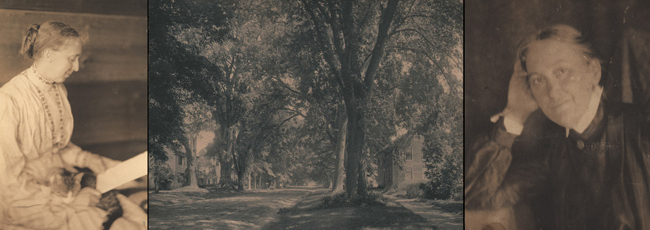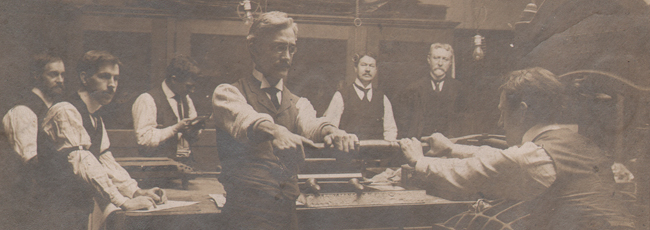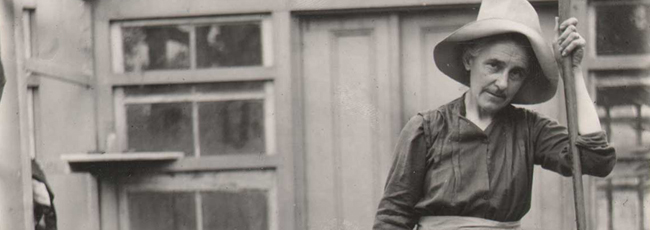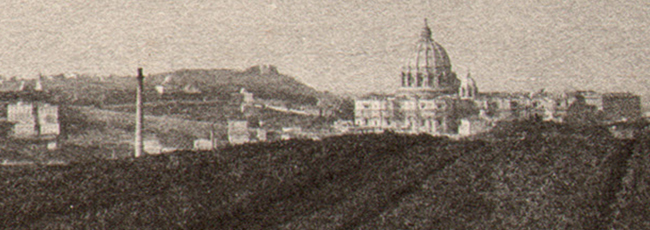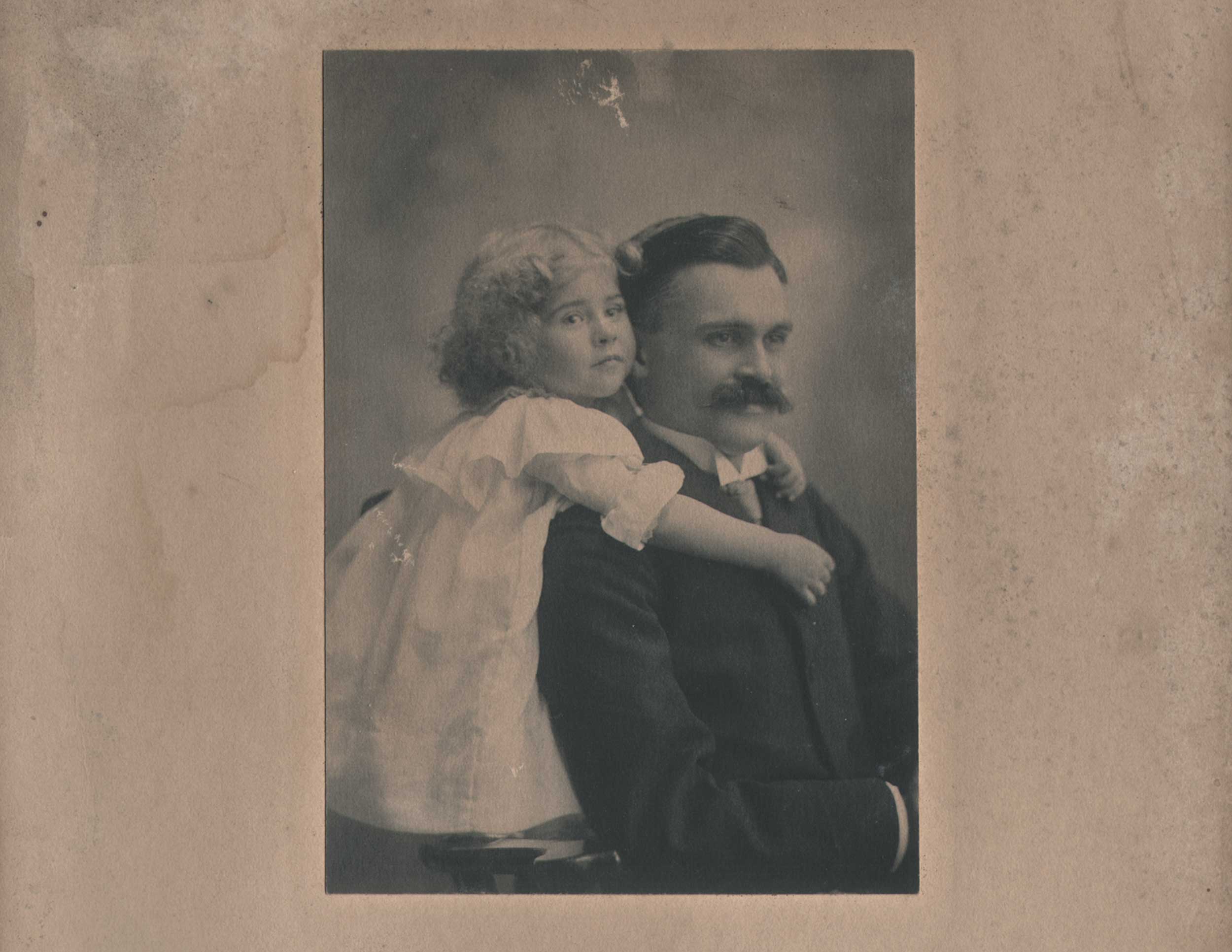
“Dorothy Tucker with father Charles Rollins Tucker”, ca. 1902. Mounted platinum print by American commercial photographers Allan Berne-Allen & Co., Stapleton, N.Y. 13.8 x 9.7 cm on card mount 25.4 x 20.3 cm. This is the only photograph from this series not believed taken by the artist. From: PhotoSeed Archive
This is the second of a two-part blog post: Rescued: Dorothy Tucker: For the Love of a Daughter, showing an intimate progression in photographs of the early life of Staten Island, N.Y. resident Dorothy Frances Tucker (1899-1986) taken by her father, Charles Rollins Tucker, 1868-1956. The post concludes with a brief historical timeline of Dorothy’s life and an afterword/remembrance from present-day family members.
Photography and fatherhood go hand in hand. With George Eastman’s introduction of the Kodak No. 1 roll-film camera in 1888, childhood would never be the same again. Moments: baby’s first steps as well as birthdays and major holidays like Christmas morning were always dutifully recorded for posterity, with the goal of compiling a heartfelt family photographic history meant to survive for eternity.
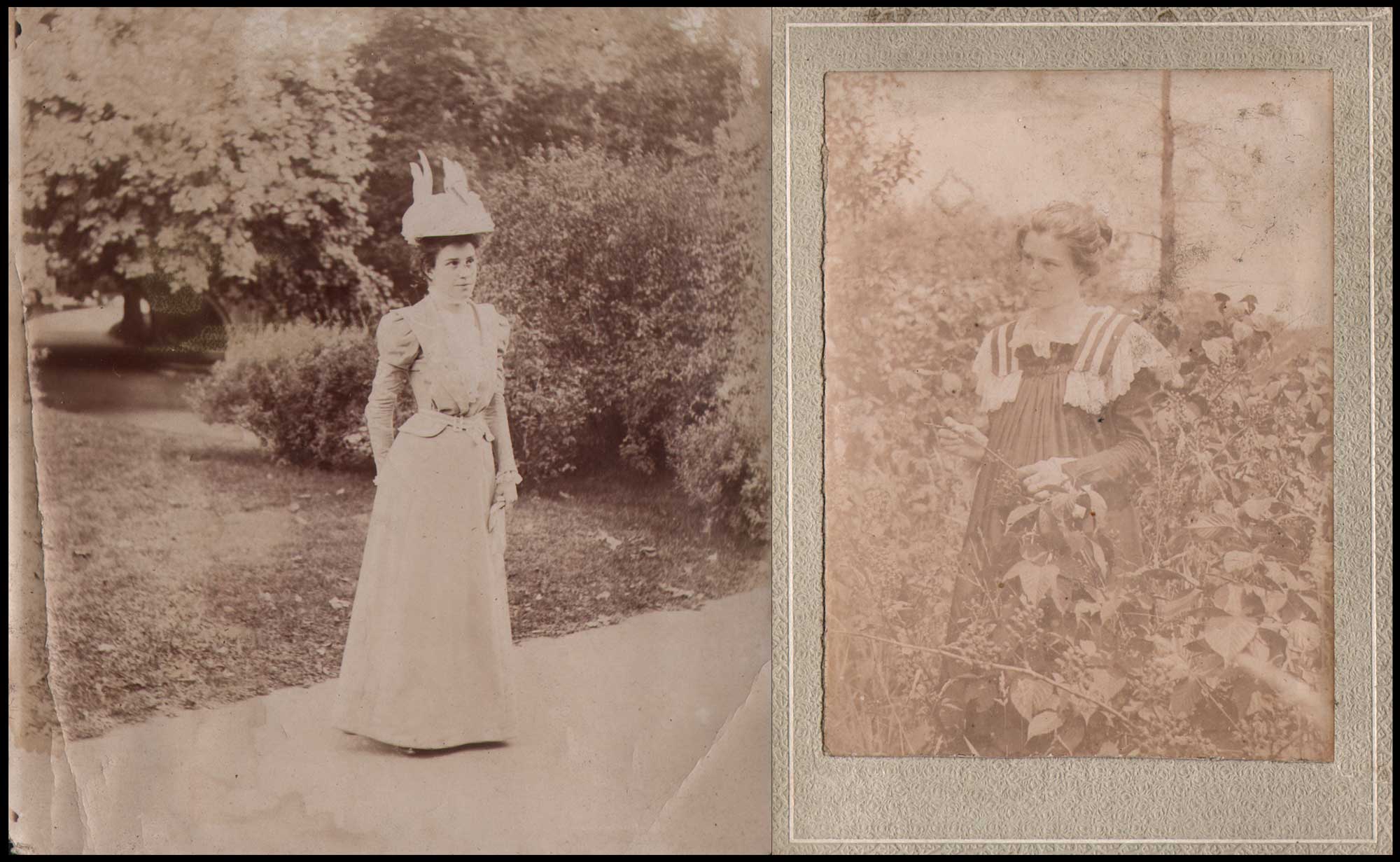
Left: “Her Wedding Dress”, unmounted POP print, ca. 1898, 11.0 x 9.9 cm; Right: “Mother in Stoughton”, ca. 1899, mounted POP print, 8.5 x 6.3 | 10.6 x 7.7 cm, both: C.R. Tucker, American 1868-1956. The subject is Dorothy’s mother, Mary Carruthers Tucker, born in Salt Lake City, UT. 1877-1940. Mary Carruthers was married in Manhattan, New York City on July 29, 1898 and at right can be seen in her maternity dress in Stoughton, MA, where Dorothy was born on August 27, 1899. Both: PhotoSeed Archive
Sadly, the reality of most of those family histories- at least the older physical snapshot albums making them up- rarely survive more than perhaps three or four generations before being discarded. History may be paved with good intentions, but photographs- even now for the trillions of images populating our ever expanding and ubiquitous digital hard drives-won’t survive.
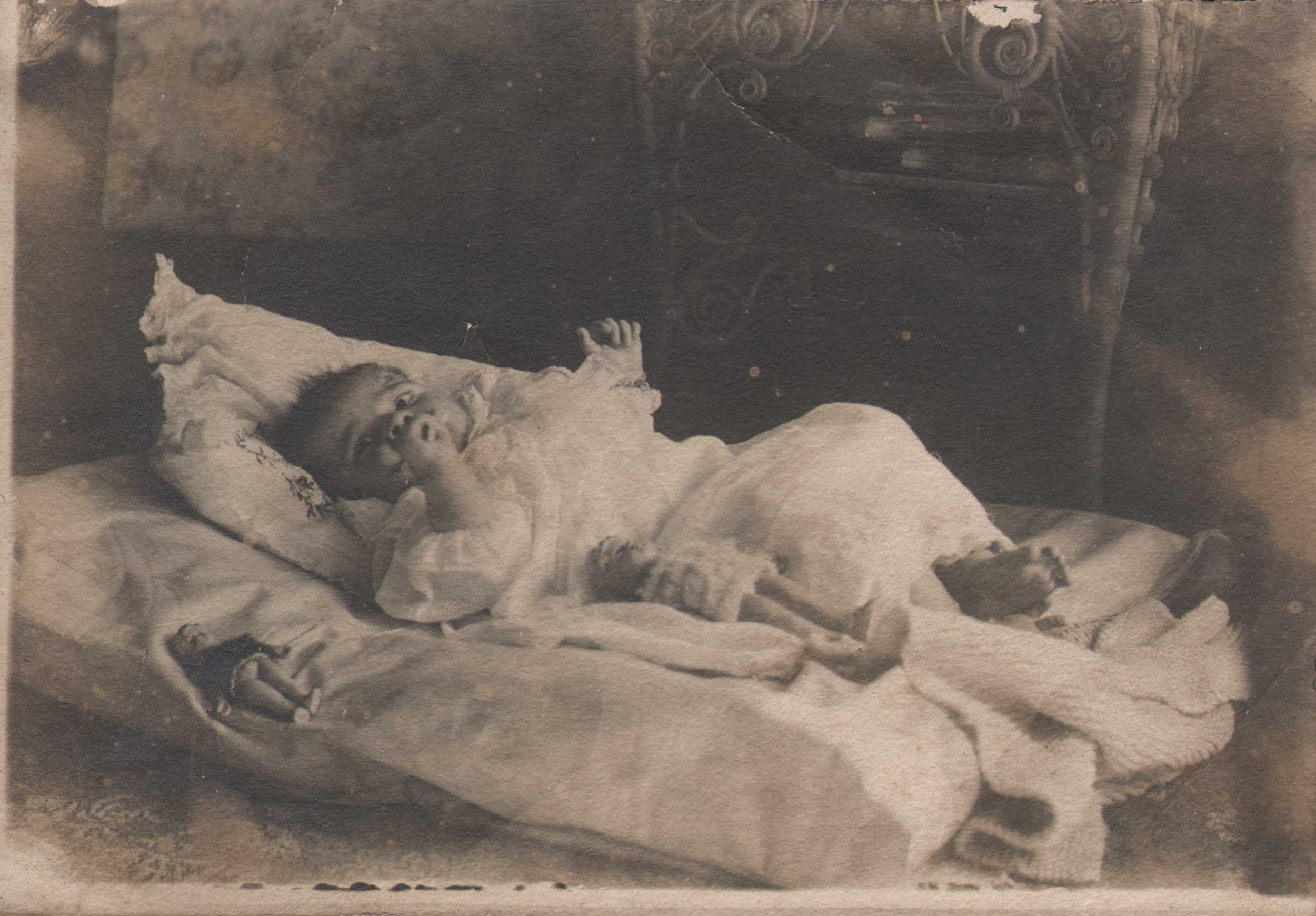
“Newborn: Dorothy Tucker”, 1899, C.R. Tucker, American 1868-1956. Unmounted gelatin silver print, 8.7 x 12.6 cm. Dorothy Tucker and her mother and father lived at 73 Clifton Place in Brooklyn, N.Y. as enumerated in the 1900 U.S. Census, but would soon move to Staten Island. Dorothy lies on a pillow and mattress placed on the floor, with several of her dolls placed at her side. From: PhotoSeed Archive

“Dorothy & her Mother”, 1899, C.R. Tucker, American 1868-1956. Platinum print mounted to heavy card, 15.4 x 10.3 | 25.1 x 20.0 cm. In this contemplative home portrait, Mary Tucker gently holds daughter Dorothy in place on her lap. This photograph must have been a favorite of the young Tucker family, as the original cloth and metal hanger is still in place on the verso of the heavy card mount. From: PhotoSeed Archive
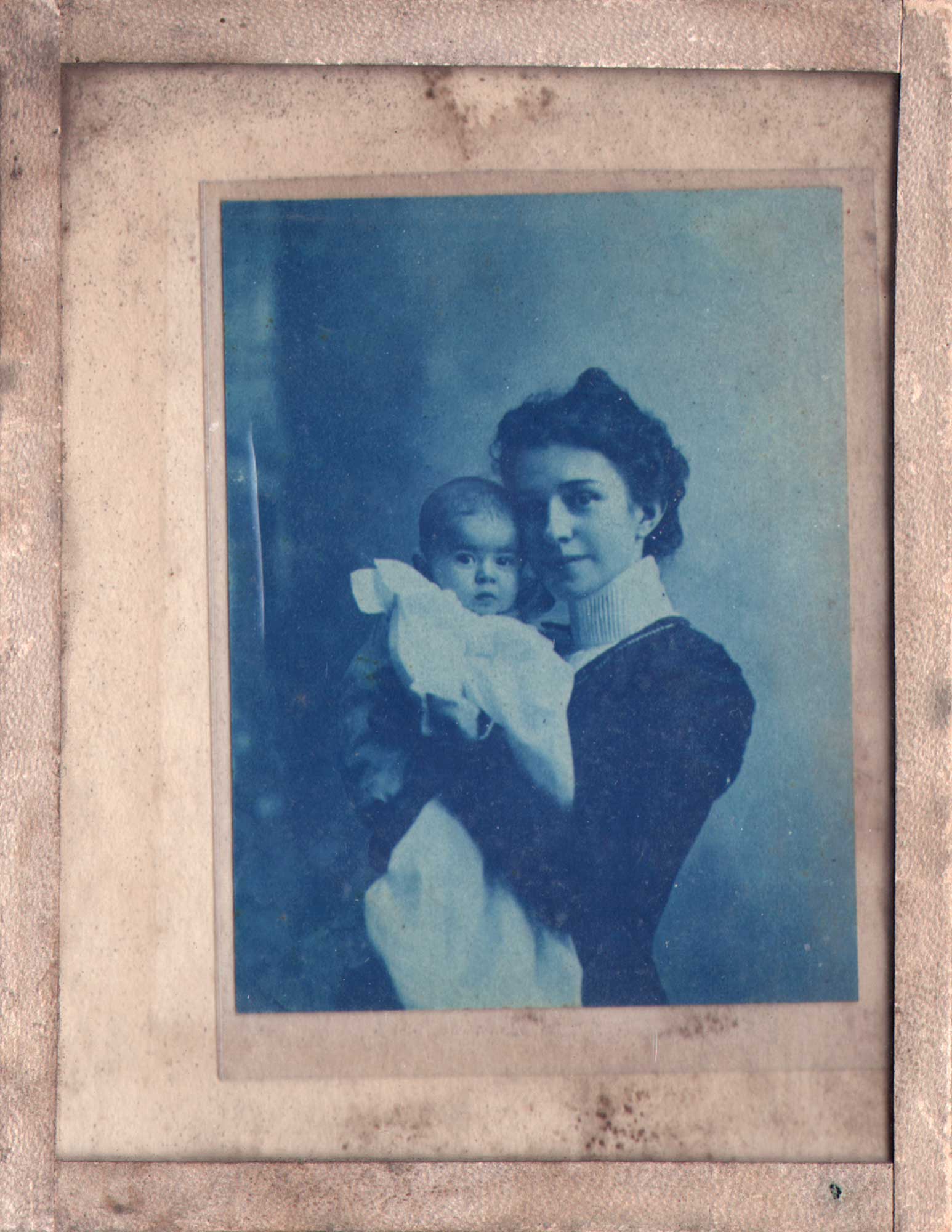
“Cyanotype: Dorothy & Mother”, 1899, C.R. Tucker, American 1868-1956. Cyanotype in original glass mount, 7.0 x 5.4 | 10.8 x 8.4 cm. This keepsake of Dorothy Tucker held by her mother is shown in its original glass and paper mount, with the loss remnants of an original cloth and metal hanger visible on the verso. Several surviving cyanotypes of Dorothy by C.R. Tucker are held by this archive. From: PhotoSeed Archive
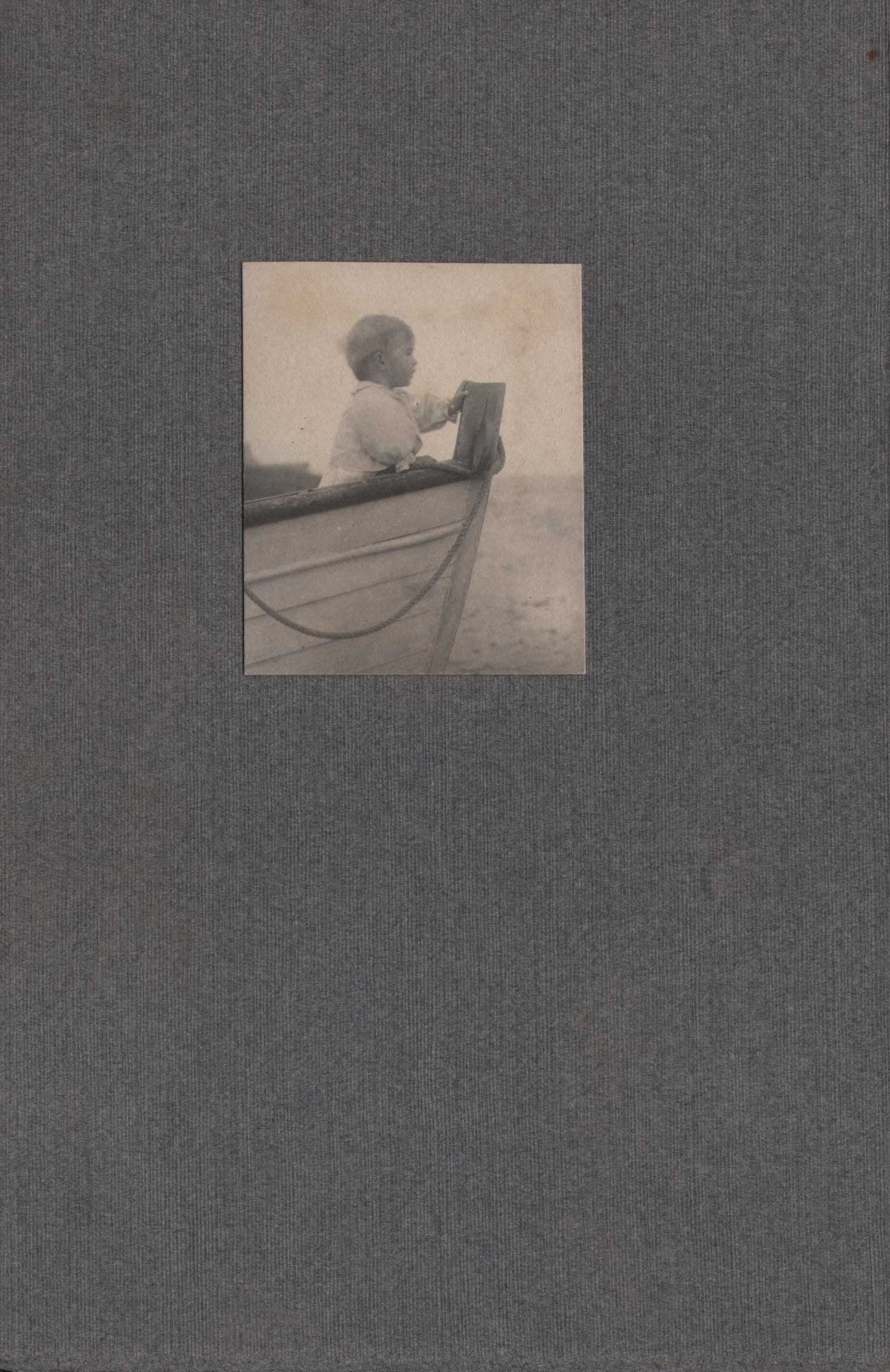
“Dorothy Tucker holding onto Boat Prow”, ca. 1900, C.R. Tucker, American 1868-1956. Mounted platinum print, 8.1 x 6.7 | 27.0 x 17.5 cm. Dorothy Tucker would appear to be less than one year old in this photograph, believed to have been taken at their summer vacation camp at Point O’ Woods on Long Island Sound. Writing anonymously in the June, 1903 issue of The American Amateur Photographer magazine illustrated by his own photographs,Tucker wrote the following thoughts as part of his article: “Our Summer Home By The Sea”: …“we have no doubt whatever that for us the most beneficial summer home has been Point o’Woods, the growth of which we have watched since July, 1894, when the bulk of the visitors were sheltered in tents on the dunes, till this year there are some seventy cottages”…From: PhotoSeed Archive
But sometimes, the detritus of a dump run gets interrupted by those with a penchant for digging up the past. Fifteen years ago, I had the pleasure of making online contact with Pennsylvania resident Pam Hegedus. Pam, known as “Lady Digger”, said her “biggest passion in life was bottle digging and metal detecting”, a hobby she had pursued since she was ten years old, and one that lasted for well over 50 years.
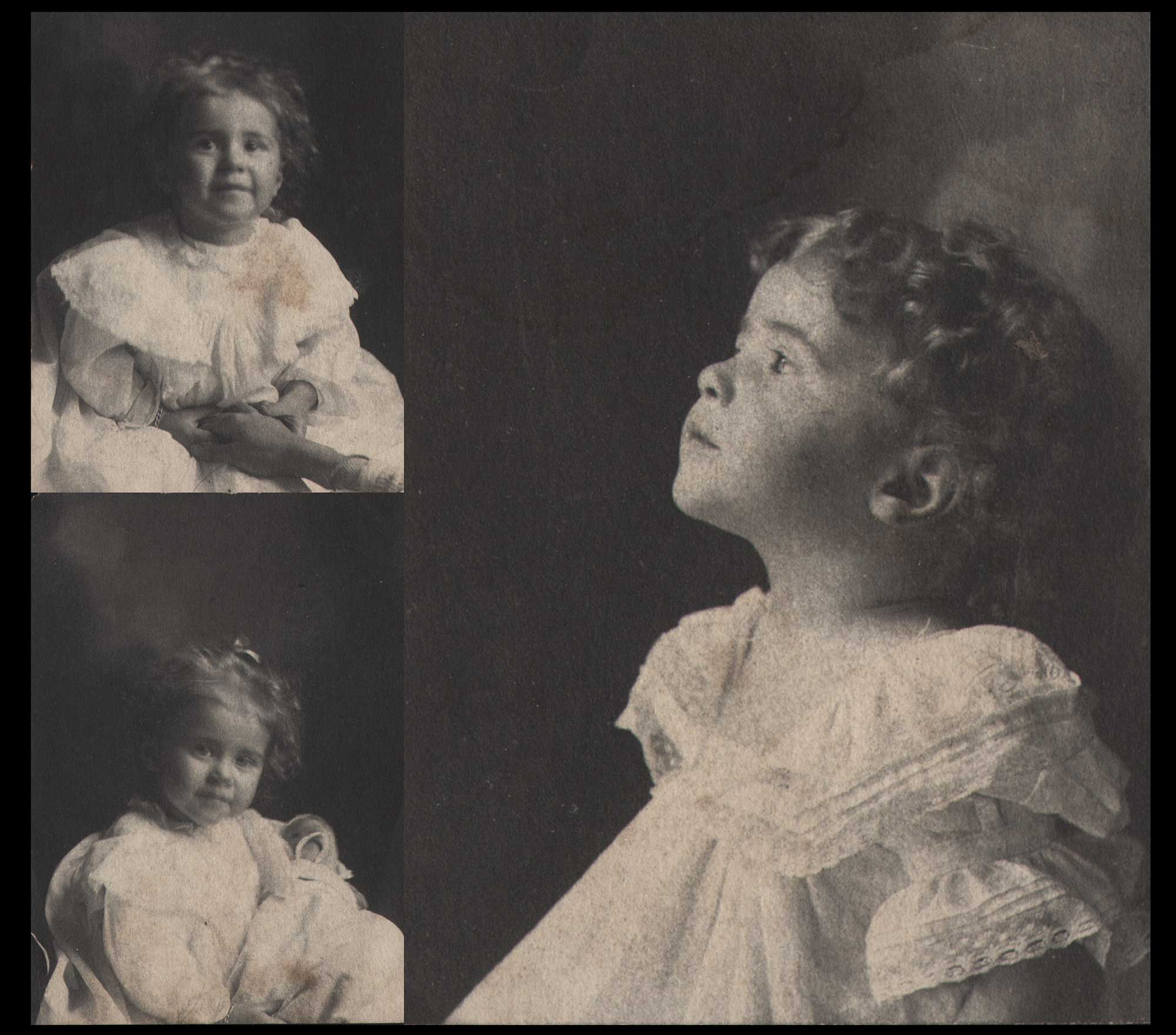
“Home Portraits of Dorothy Tucker, about One year Old”, ca. 1900, C.R. Tucker, American 1868-1956. Unmounted platinum prints, each around 8.7 x 6.3 cm. C.R. Tucker trained his amateur camera with great joy at his newborn daughter, with these home portraits done with natural light. An adult hand steadies Dorothy at upper left while she looks a bit tuckered out (no pun intended) at lower left; a profile angle completing this triptych. From: PhotoSeed Archive
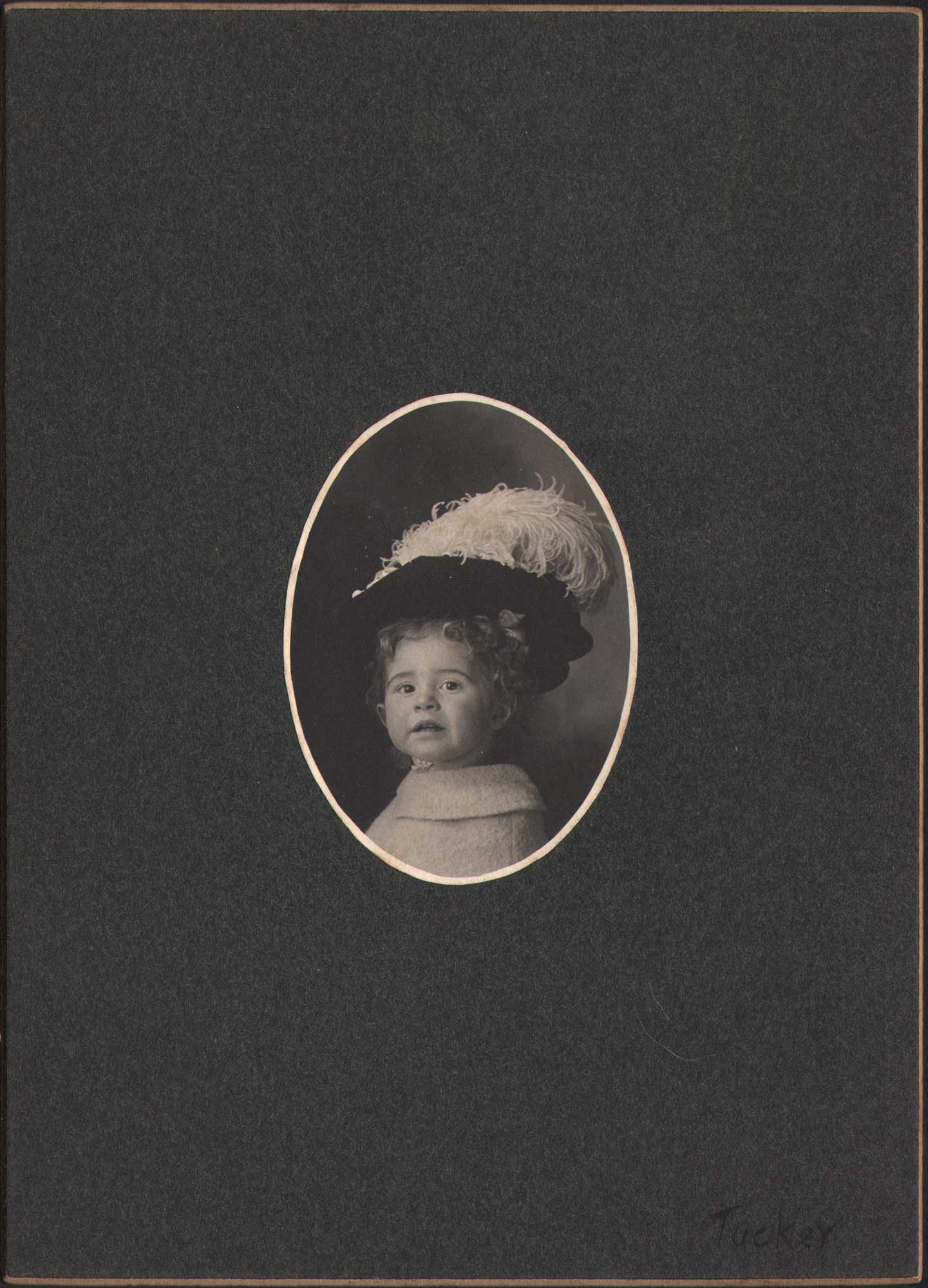
“Dorothy Tucker wearing Plumed Chapeau”, 1900, C.R. Tucker, American 1868-1956. Platinum print affixed to beveled mount, 7.0 x 5.0 | 18.1 x 13.1 cm. A bit of effort was put in to create this more stylized home portrait of Dorothy. The artist surname appears on the mount at lower right and is dated 1900 on the mount verso, along with print type and name of subject in graphite: “Dorothy T.” From: PhotoSeed Archive
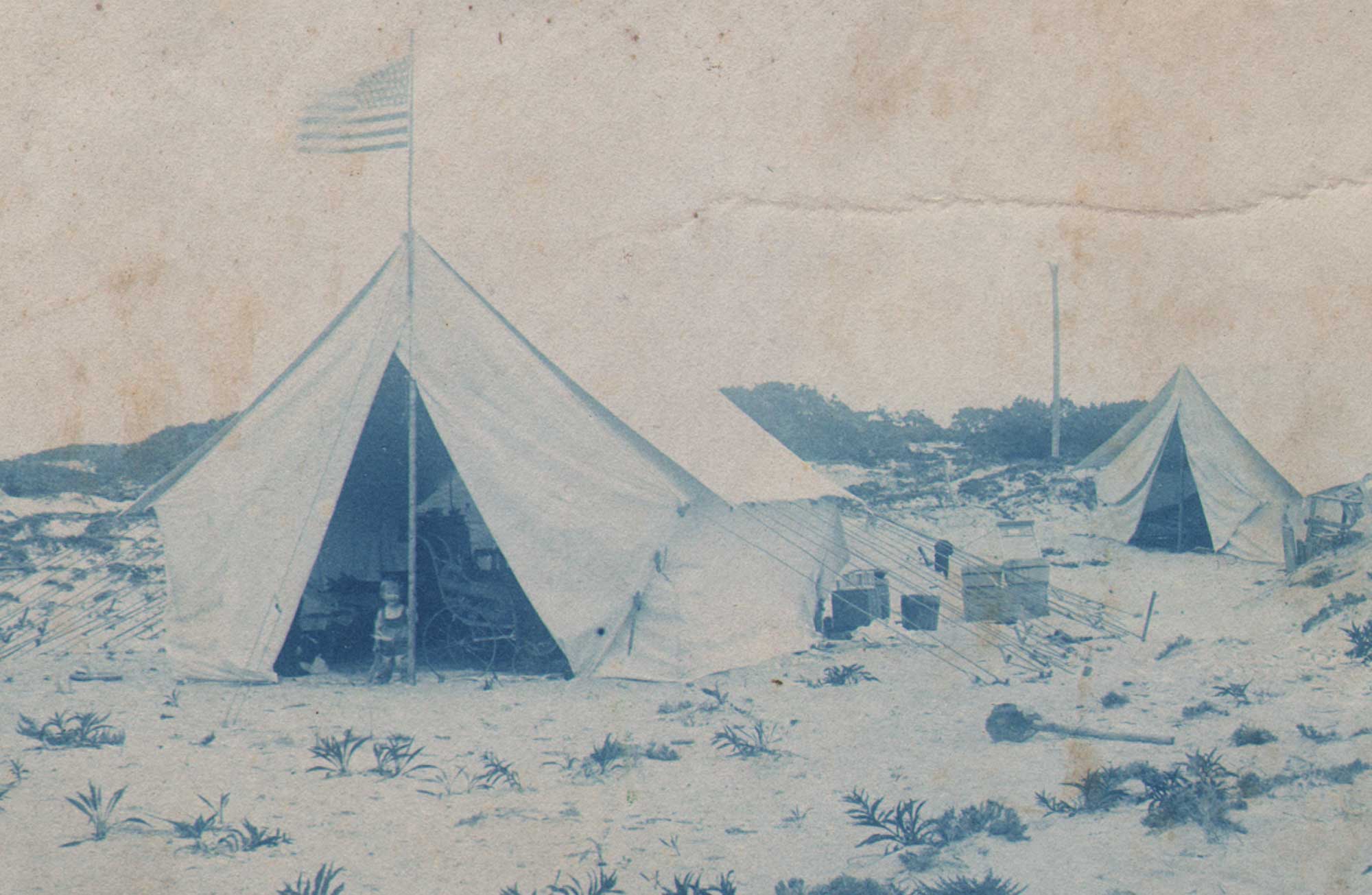
“Dorothy Tucker at Point O’ Woods Beach Camp”, ca. 1900-01, C.R. Tucker, American 1868-1956. Unmounted cyanotype print, shown cropped, 11.5 x 17.5 cm. Dorothy Tucker, who appears no older than two years old in this photograph, stands at the entrance to a large canvas tent with American flag flying overhead on the beach at Point O’ Woods on Long Island Sound. This photograph was published in the June, 1903 issue of The American Amateur Photographer magazine. Dorothy’s father, writing anonymously, compiled his thoughts for the article: “Our Summer Home By The Sea”, in which he outlined the growth of the summer vacation colony retreat since its founding in 1894. Wikipedia notes the private retreat Point O’Woods -even today-“ may have been the first settlement on Fire Island in Long Island Sound, and was originally organized in 1894 for religious retreats, including some from the Chautauqua assemblies before ownership passed to the present-day Point O’ Woods Association in 1898 after the first group went bankrupt.” From: PhotoSeed Archive
And that’s where this lovely story of fatherhood and photography collided. Because of Pam’s realization someone might be interested in them, the photographs you see here of “Dorothy” were saved by her and then purchased for this archive.
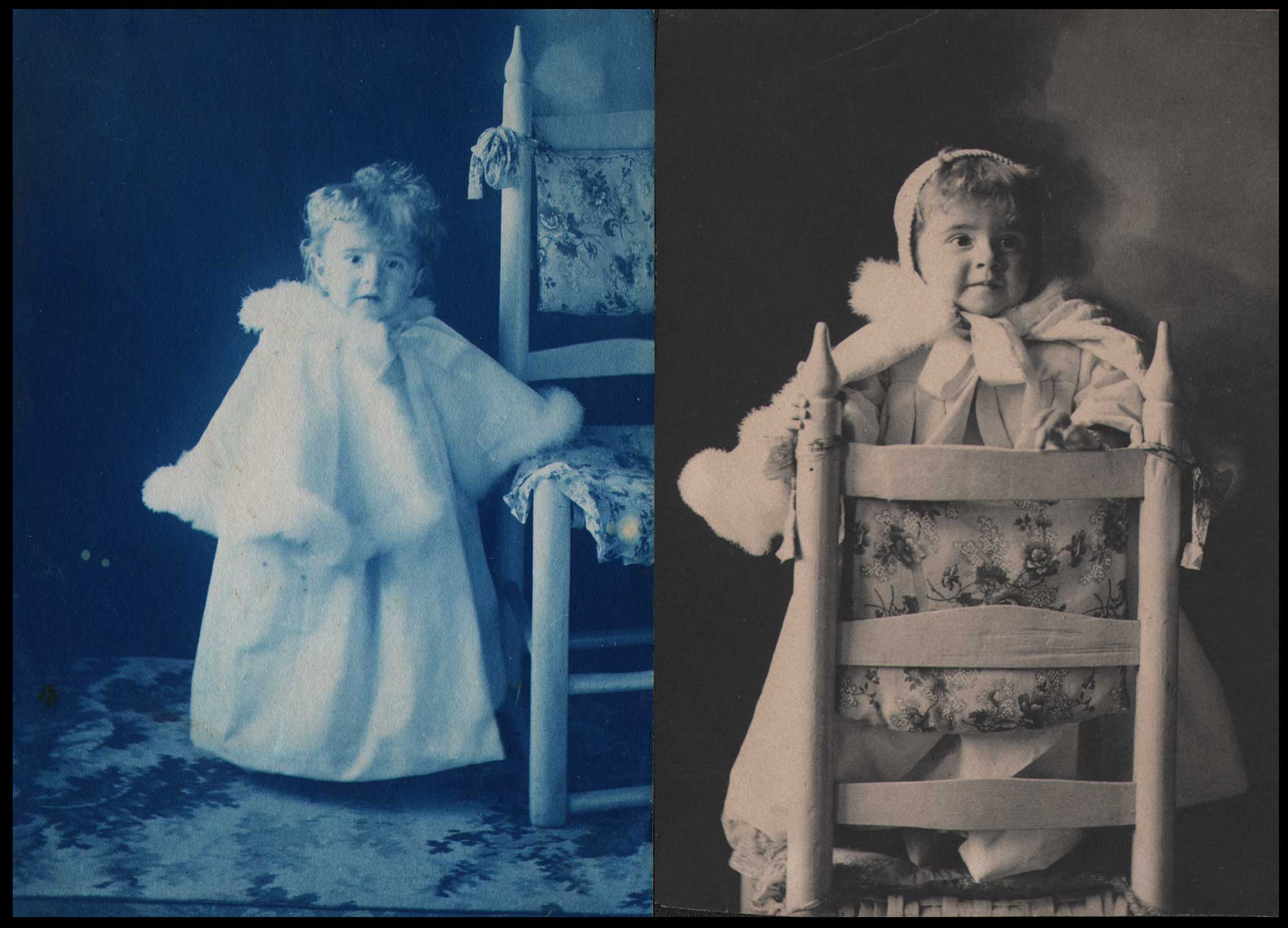
Left: “Dorothy: Chair Study Printed in Cyanotype”, Right: “Dorothy: Chair Study Printed in Platinum”, ca. 1900-01, C.R. Tucker, American 1868-1956. (L.) 12.2 x 8.7 cm & (R.)10.5 x 7.3 cm. Dorothy wears a fur-lined outer jacket over a long white dress while holding onto and standing on a ladderback chair: a home portrait done with natural light. From: PhotoSeed Archive
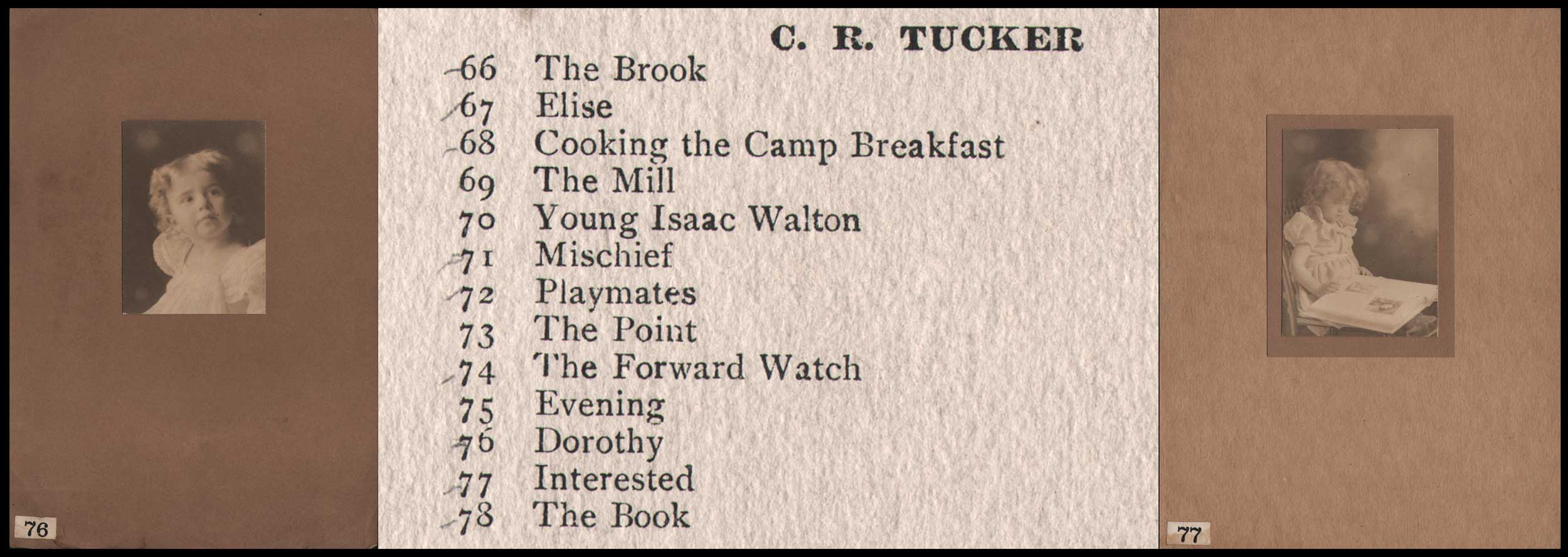
Center: Detail from Exhibition Catalogue: “A Loan Collection of Photographs Exhibited by Davis & Banister”, which took place in Worcester, MA from April 23rd to 30th, 1906, & which C.R. Tucker was an exhibitor. Left: “Dorothy”, ca. 1903-04. C.R. Tucker, American 1868-1956. 9.4 x 6.9 | 26.3 x 17.9 cm. Mounted exhibition print by Tucker, #76, included; Far Right: “Interested”, ca. 1903-04. 9.6 x 7.2 | 11.2 x 8.7 | 25.3 x 18.8 cm. Mounted exhibition print by Tucker, #77, included. These exhibition prints featuring Dorothy are rare survivors of an early American photographic exhibition organized by Dwight A. Davis, Worcester’s most notable pictorialist photographer of the early 20th Century.From: PhotoSeed Archive
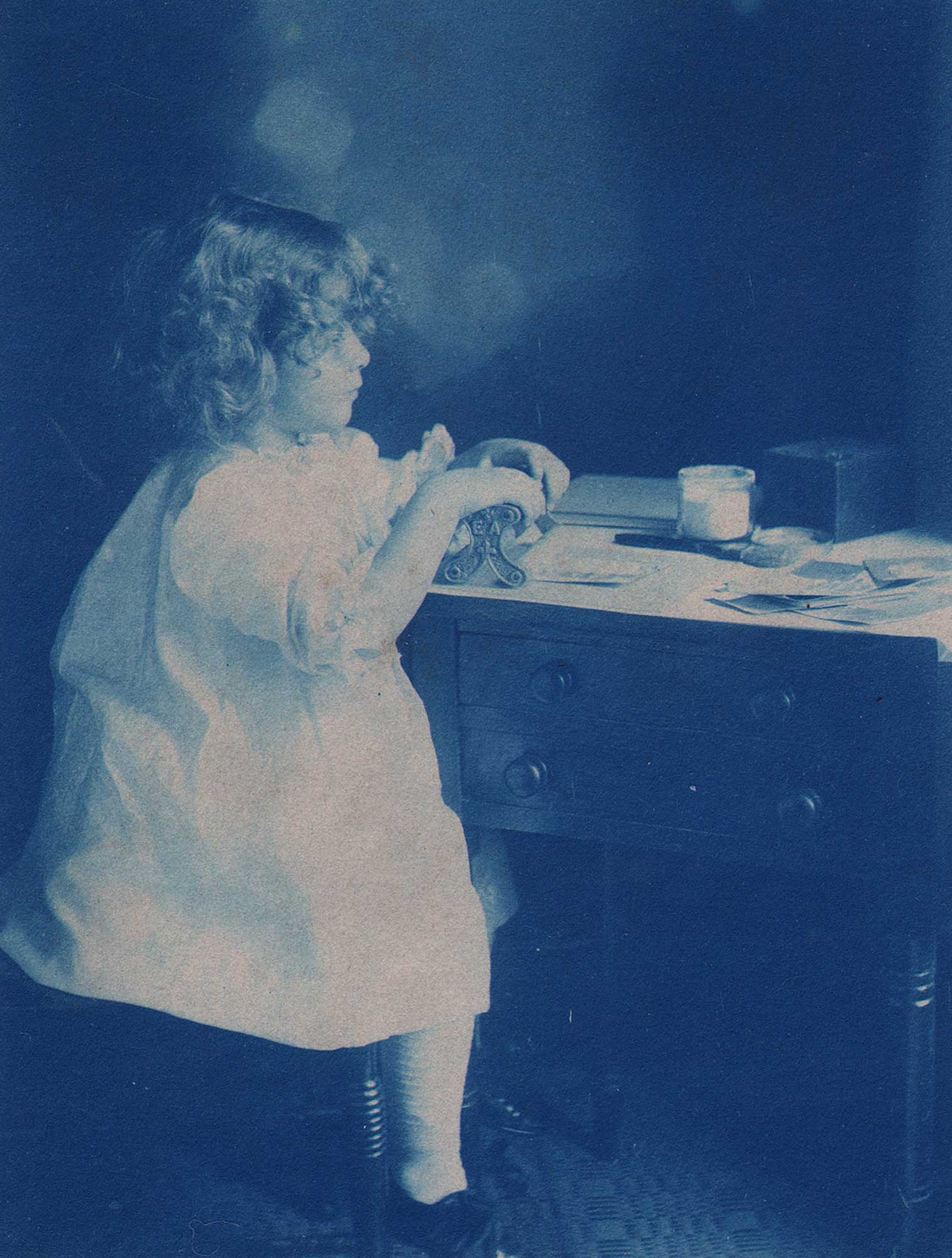
“Dorothy Tucker Mounting Photographs”, mounted cyanotype print, ca. 1903-04. C.R. Tucker, American 1868-1956. 11.3 x 8.6 | 15.0 x 12.6 cm. Seated on a stool, Dorothy Tucker uses an E. & H.T. Anthony brand Print Mounter to mount a photograph on a work table. Possibly taken for one of the yearly amateur Kodak advertising contests, the work space shows a Kodak Brownie camera at right rear, loose photographs, an album and jar of what is most likely Daisy brand mounting paste with a brush next to it. Gripping the top of the mounter, Dorothy prepares to slide the mounter with its two rollers over a print seen just to the right of it. From: PhotoSeed Archive
Sadly, life intervened, as it does for all of us, and I never followed up with a personal visit to meet Dorothy’s savior, as I just recently found out Pam died a number of years ago. “By all means, keep in touch and come by anytime you are in the area. I’d like that” Pam wrote me in October, 2010.

“Dorothy Tucker photographs her Dolly”, mounted platinum print, ca. 1904-05. C.R. Tucker, American 1868-1956. 11.0 x 13.6 | 31.6 x 26.6 cm. The hobby of amateur photography was a constant in the early life of Dorothy, as practiced by her father, but was also taken up by herself before she was a teenager. Here, Dorothy prepares to squeeze a bulb shutter while photographing her dolly. This photograph or variant was likely entered in one of the annual “Kodak Competitions” from the period, as it features the company’s products, including a tripod-mounted plate camera. (undetermined model) A camera and tripod case can be seen on floor along with a single plate holder and dark cloth. Dorothy holds the dark slide for the camera in her left hand while making the exposure. Inset: Published in 1907, this original advertisement shows Dorothy holding a cat & appeared on behalf of Bausch and Lomb-Zeiss Tessar lenses “Home Portraits” in Camera Work XVII for January. The ad was also published in other contemporary mass-market photographic journals. Mounted photo: From PhotoSeed Archive
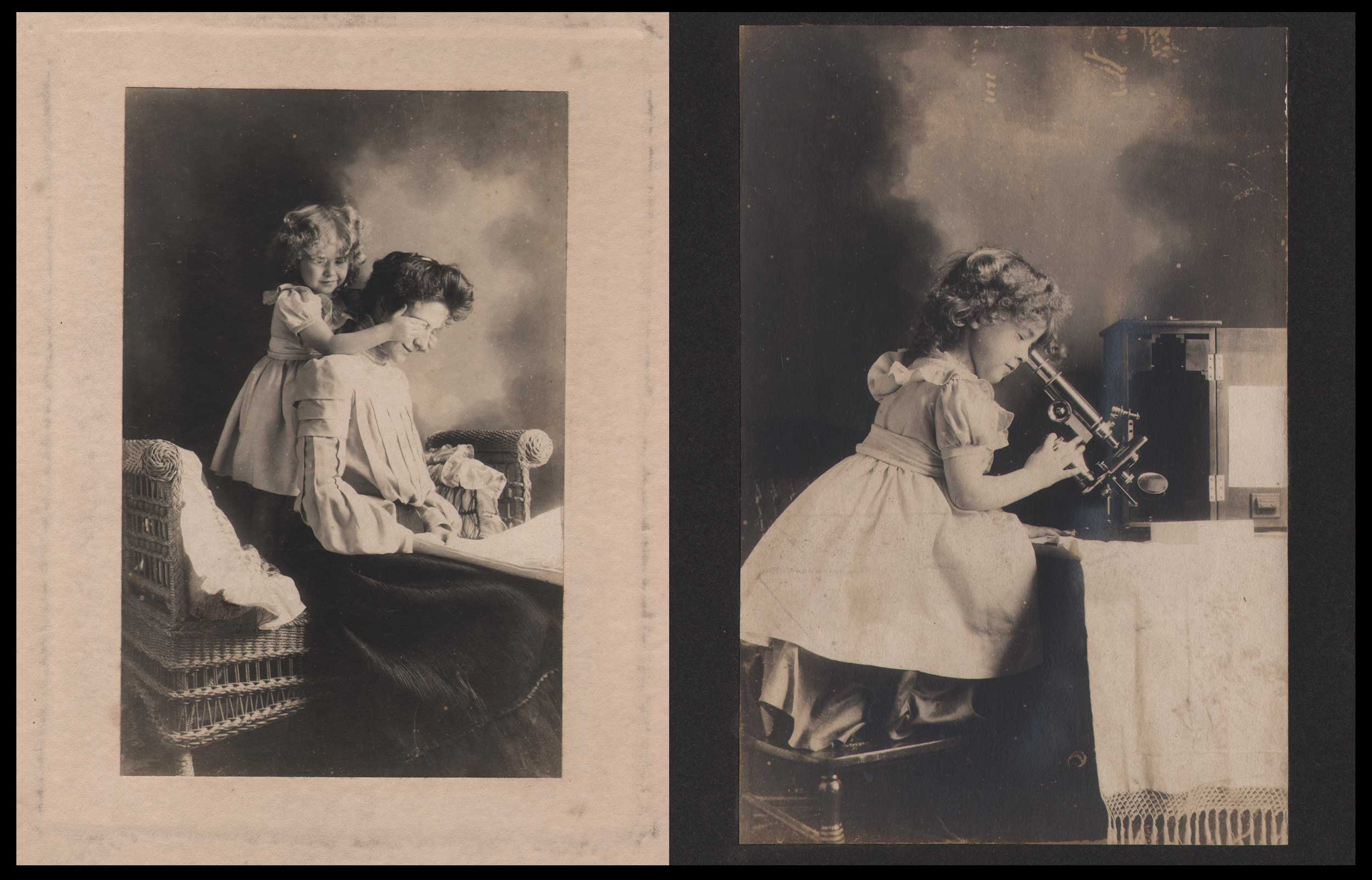
Left: “Dorothy Plays a Game of Guess Who? with her Mother”, mounted bromide or gelatin silver print, ca. 1904-05. C.R. Tucker, American 1868-1956. 16.5 x 10.6 | 30.5 x 25.5 cm. In another home portrait, Dorothy clasps her hands around her mother Mary’s eyes while seemingly playing a game of Guess Who?. Right: “Dorothy with Microscope”, mounted gelatin silver print, ca. 1905. C.R. Tucker, American 1868-1956. 17.0 x 11.4 | 23.4 x 18.5 cm. Seated on a stool placed on a chair, Dorothy examines something placed under a microscope, which her father may have owned or borrowed from Curtis High School in Staten Island, where he taught physics, among other courses. From PhotoSeed Archive
The story of Dorothy Tucker’s resurrection, so to speak, did not come from the many holes in the ground dug by Pam in search of bottles and valuable metal objects but of her other penchant for treasure hunting in dilapidated buildings. From what I have been able to piece together with my online correspondence, she had come across a condemned home in her neck of the woods, several miles from her own home. “The old place is about fallen down now with caved in floors–sad, as the outside looks so nice. I will return next week and go through more things before they actually tear it down” she told me in one email from 2010.
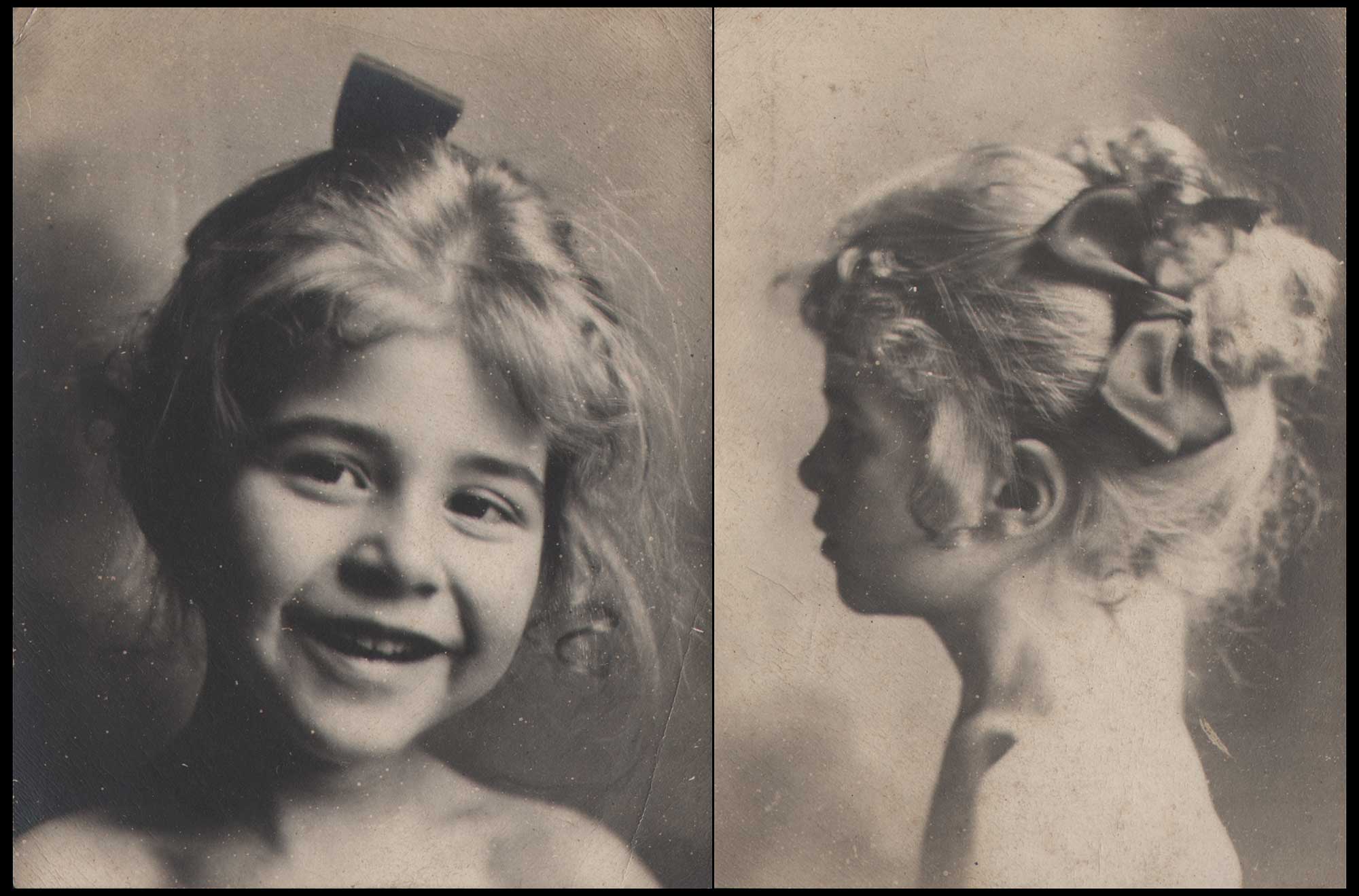
Left: “Dorothy: Head Study”, Right: “Dorothy: Profile Study”, ca. 1904-05, both: unmounted gelatin silver prints. C.R. Tucker, American 1868-1956. L: 10.0 x 7.9 cm | R: 10.9 x 7.8 cm. From: PhotoSeed Archive
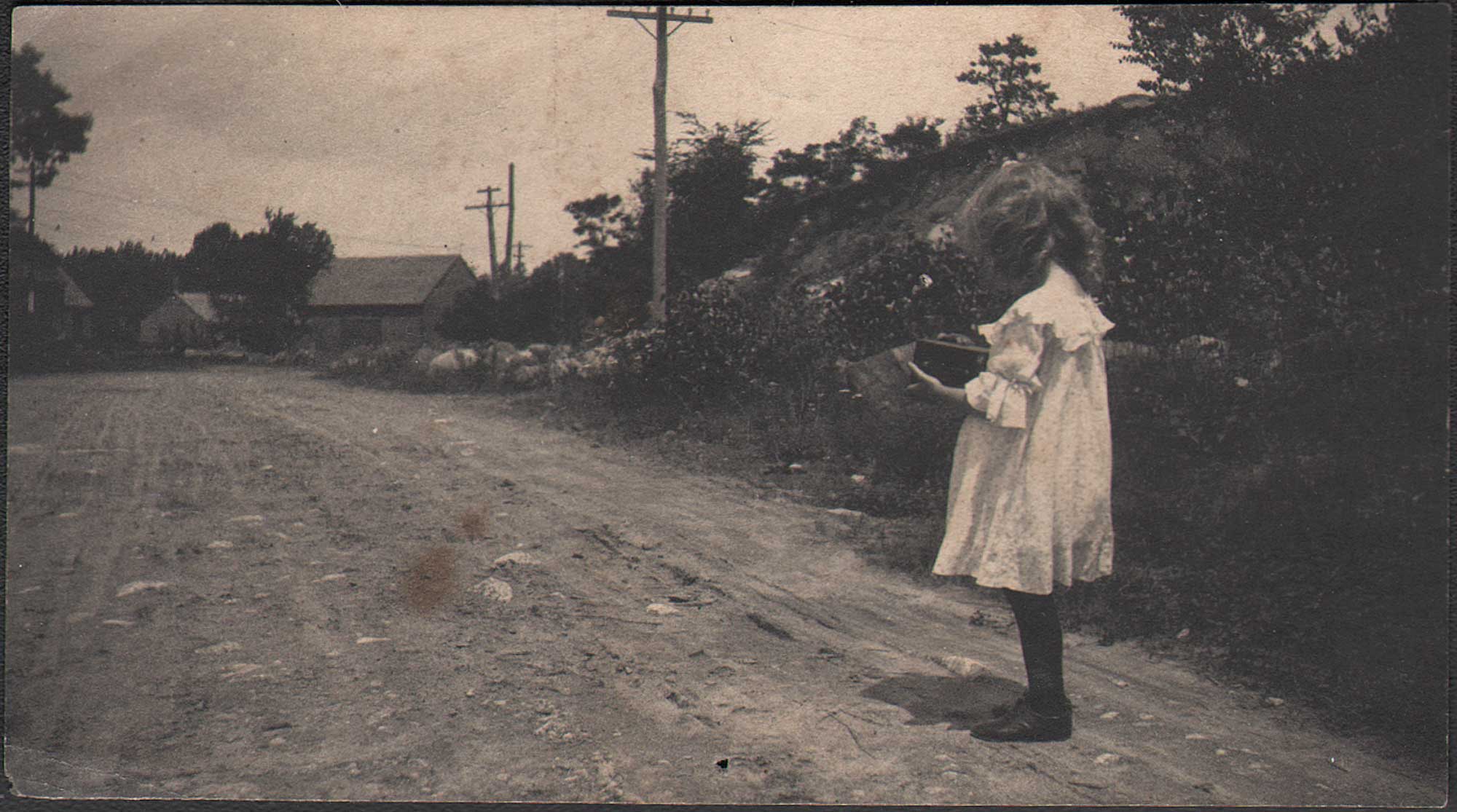
“Dorothy at N. Stoughton Takes a Photograph”, ca. 1905, unmounted platinum print, C.R. Tucker, American 1868-1956 or Tucker family member, 5.8 x 10.4 cm. “Grandma wanted me to send you this” is printed on the verso of this photograph. Dorothy, using a “Brownie” style Kodak camera, appears to frame the shot while standing on a dirt road in North Stoughton, MA. From: PhotoSeed Archive
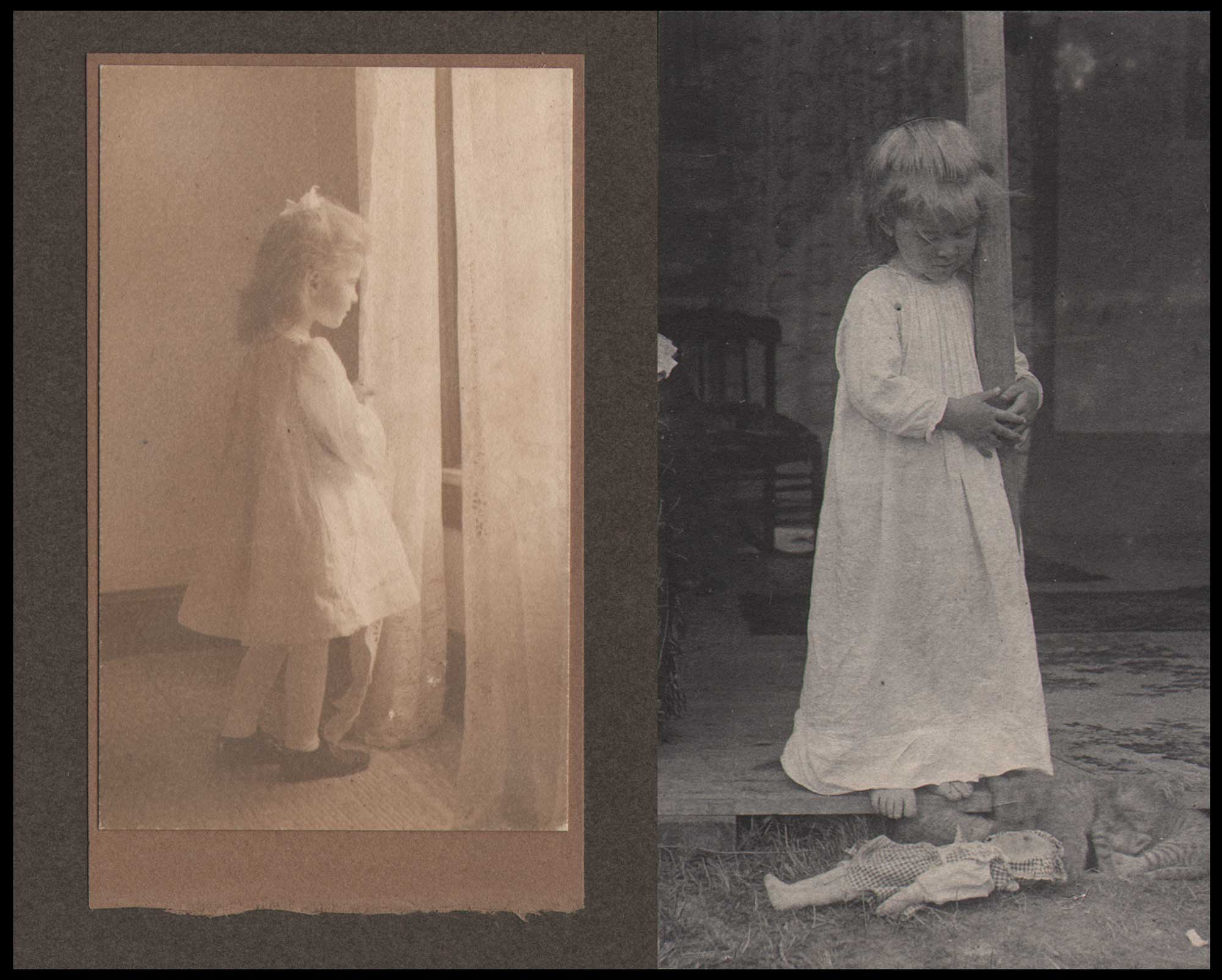
Left: “Watching for Papa”, Right: “Dorothy Looking Down at Doll”, ca. 1905, Left: mounted platinum print; R: unmounted platinum print, C.R. Tucker, American 1868-1956. L: 11.1 x 6.8 | 12.5 x 7.2 | 24.3 x 16.6 cm | R: 10.0 x 6.0 cm. From: PhotoSeed Archive
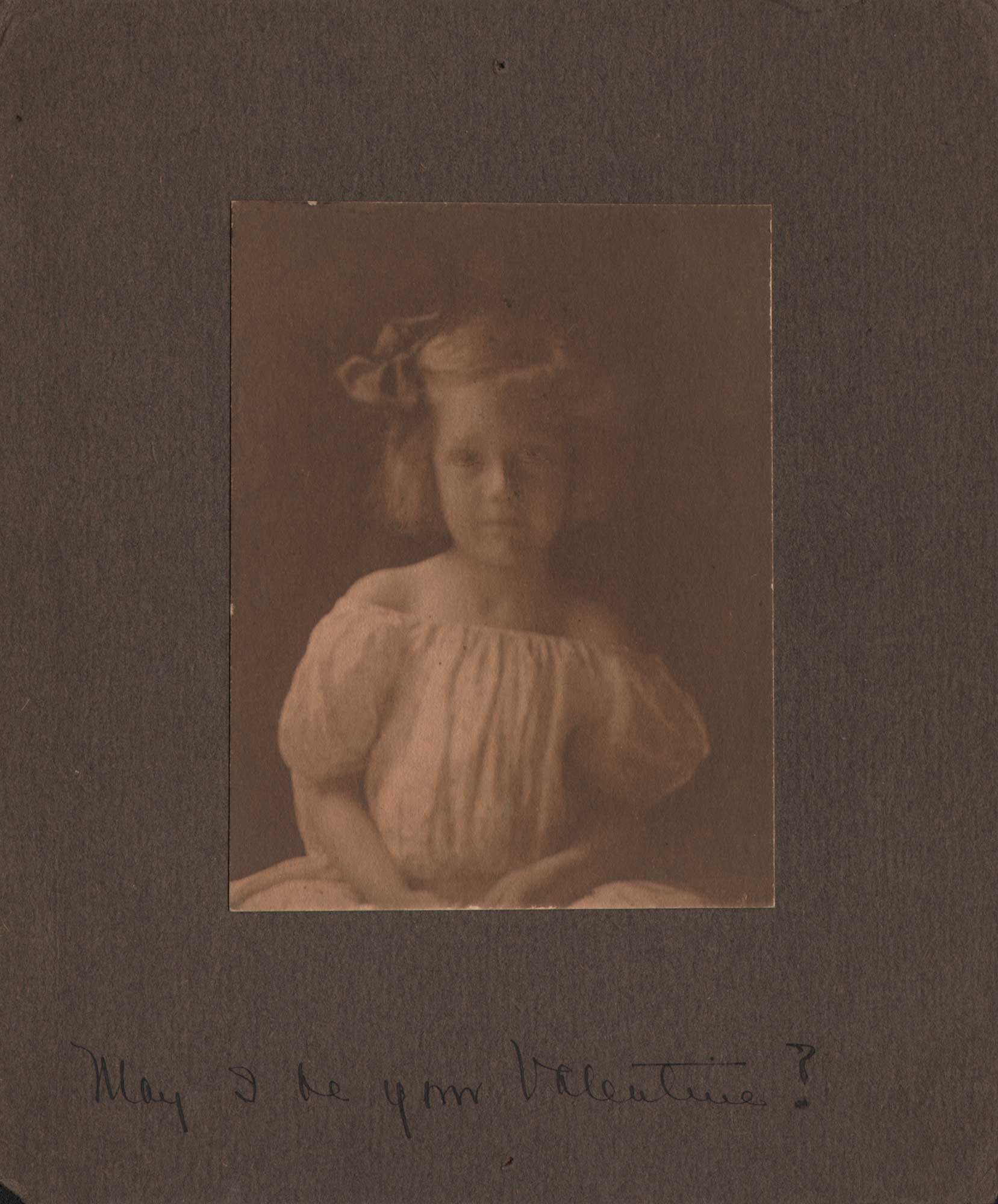
“May I be your Valentine? For Cousin Katharine with Dorothy’s Love”, ca. 1905-06, mounted platinum print, C.R. Tucker, American 1868-1956. 11.6 x 8.9 | 19.9 x 16.6 cm. Photographic greeting cards were a relatively new outlet for ambitious amateurs like Dorothy’s father, with this rich brown platinum print set off against a brown art paper mount complimentary to the hand-drawn sentiment along bottom margin. The recipient, Dorothy’s cousin Katharine, was penned on the card’s verso. From: PhotoSeed Archive
Even now, I admit to spending way too much time online in search of photographic treasure, but the collector in me knew that what Pam was posting for sale was a truly significant and unusual archive : the story of one girls’ life: “Dorothy”, from infancy to well past her teenage years. The single thing keeping it all together for me? The name “Dorothy” penciled onto the verso of the majority of photographs making up this hoard.
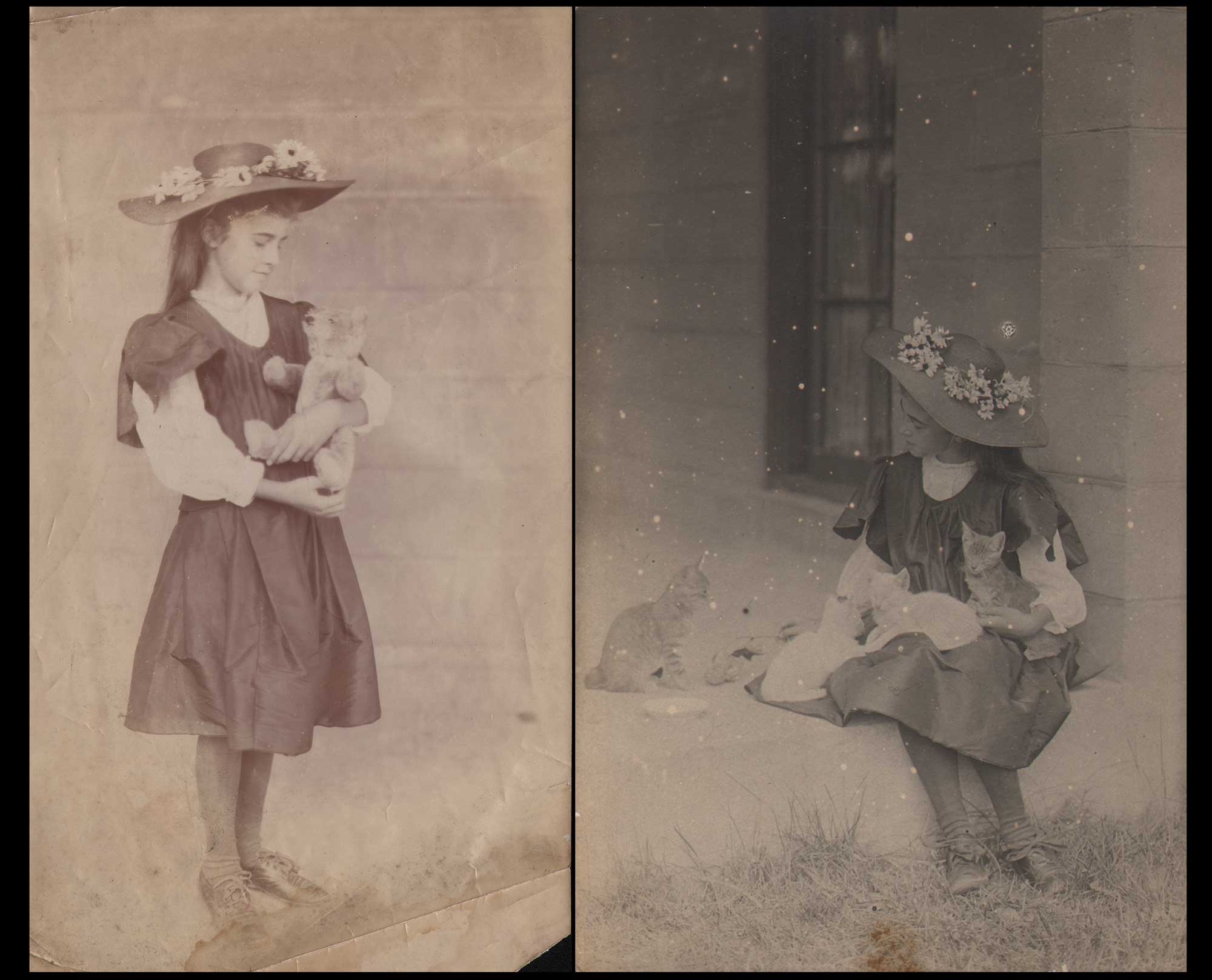
Two portraits of Dorothy outside her family home, then at 90 Third Street in the New Dorp section of Staten Island: Left: “Dorothy with Teddy Bear”; Right: “Dorothy with Kittens”, ca. 1906-07, unmounted POP and gelatin silver print- rppc stock, C.R. Tucker, American 1868-1956. Left: 26.6 x 15.0 cm, Right: 13.0 x 8.4 cm. The innovative home, believed to have built ca. 1904-05, nearly entirely of concrete, was radical for the era and unintentionally provided clean backgrounds for a series of portraits of Dorothy by her father. From: PhotoSeed Archive
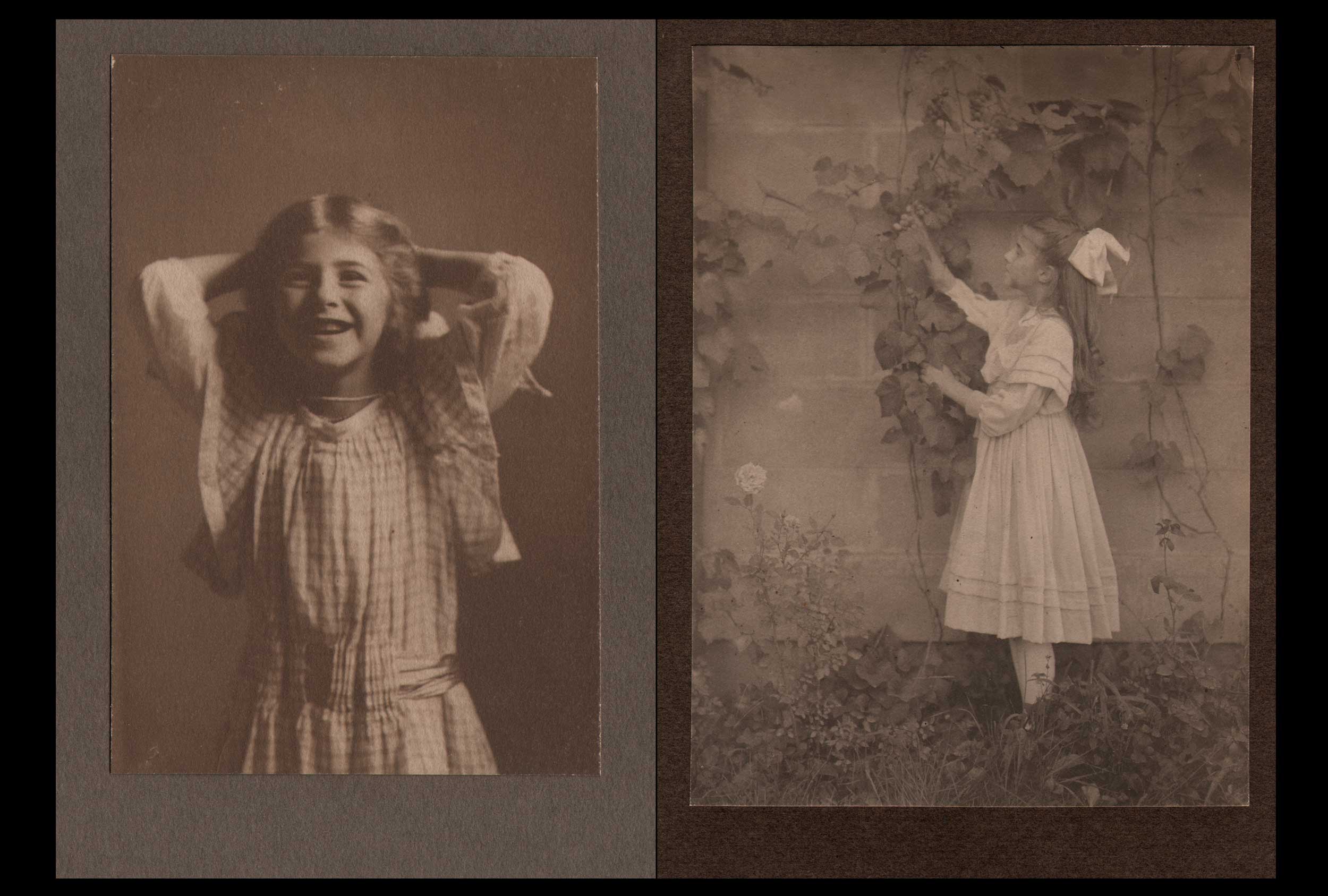
Left: “Dorothy laughing and Striking Pose with Hands Behind Head“, ca. 1907-08, mounted platinum print, 14.8 x 10.0 | 28.5 x 17.9 cm. Right: “Dorothy Reaching for Grapevine outside Family Home”, 1909, mounted platinum print, 20.0 x 14.7 | 33.7 x 22.3 cm. Both: C.R. Tucker, American 1868-1956. The Tucker family home, then located at 90 Third Street in the New Dorp section of Staten Island, was nearly new (they are believed to have been the second owners after W.J. Steel) when the family moved in by 1906. The home itself was the subject of an extensive article illustrated with photographs (several showing Dorothy seated outside) in the August, 1906 issue of American Homes and Gardens magazine. A nearly fireproof structure, the article stated: “With walls and partitions of hollow concrete blocks, floors and roof of reinforced concrete, it was the first building of this character to be constructed in New York City.” The grapes are seen growing against the concrete block work wall in photo at right. From: PhotoSeed Archive
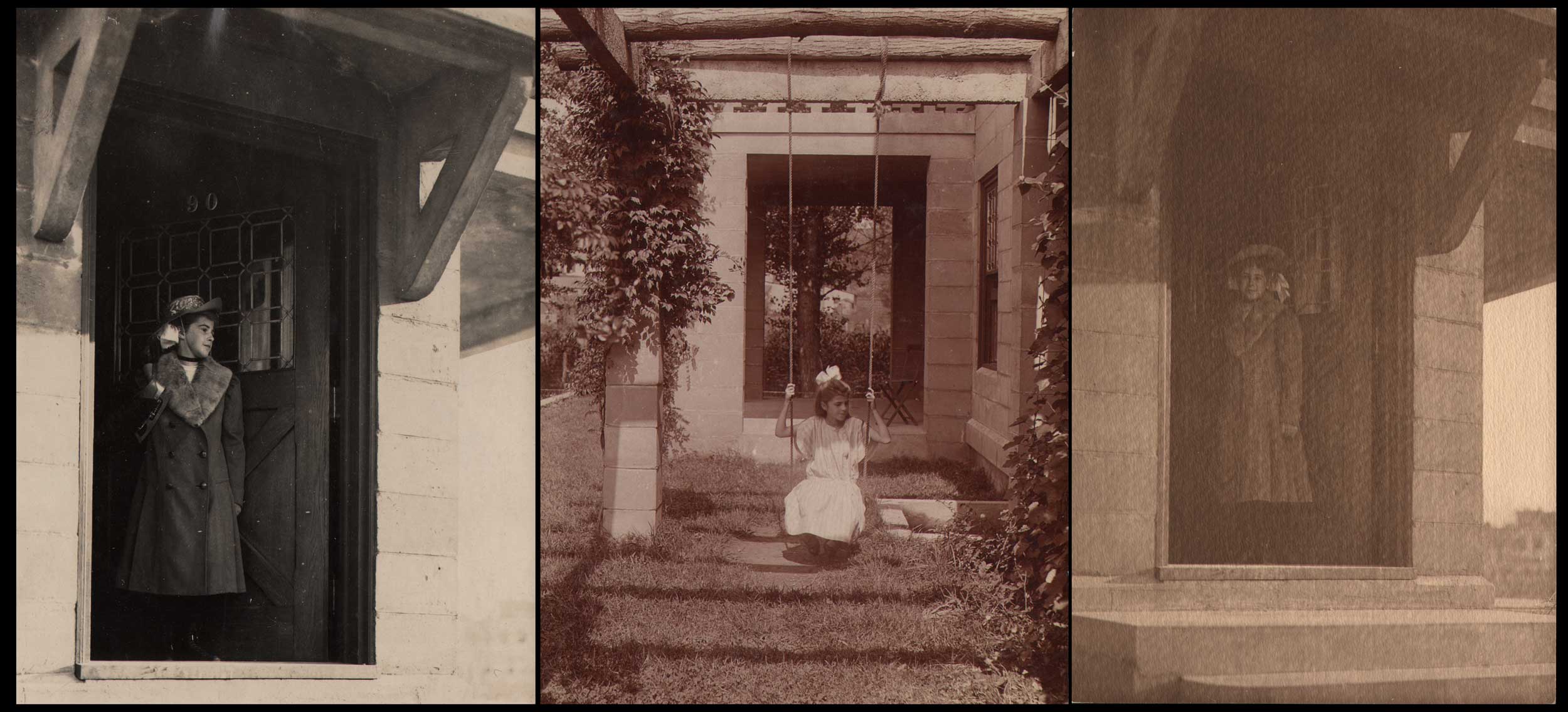
Exterior photographs show Dorothy posing and playing at the family home, then at 90 Third Street in the New Dorp section of Staten Island. No longer standing, it was believed built ca. 1904-1905 and designed by Robert Waterman Gardner, 1866-1937, president of the New York Society of Craftsmen and an architect who pioneered using reinforced concrete in residential construction. The Tucker family were believed to be the second owners after the first, W.J. Steel. Left: “Dorothy with Ice skates in Home Entranceway”; Middle: “Dorothy on Swing in Pergola”; Right: “Dorothy in Home Entranceway”, all: ca. 1908-09: unmounted POP prints and right: textured platinum print, C.R. Tucker, American 1868-1956. L: 16.8 x 11.8 cm; M: 17.1 x 11.8 cm; R: 16.5 x 11.5 cm. The house number, #90, can be seen above the inset, leaded beveled glass front wood entry door. The 1906 American Homes and Gardens magazine article further describes the front entrance as: “covered with a hood built entirely of concrete, the brackets and roof being reinforced with plain round rods”. And the pergola: “the columns of which are built up square, with girders of reinforced concrete carrying rafters of small poles left with the bark on.” From: PhotoSeed Archive
And what a hoard. To my eye, these photographs were done by a master amateur photographer. At first, I did not know the identify of Dorothy’s photographer, or even who she was. It took me over a year of doing genealogy to finally nail things down, and keen observers of this website may remember several examples of “Dorothy” photographs posted. To be realistic, not every photograph can or should be saved, but when someone as talented as Dorothy’s photographer emerges from the shadows, it’s worth at least a little effort to intervene.
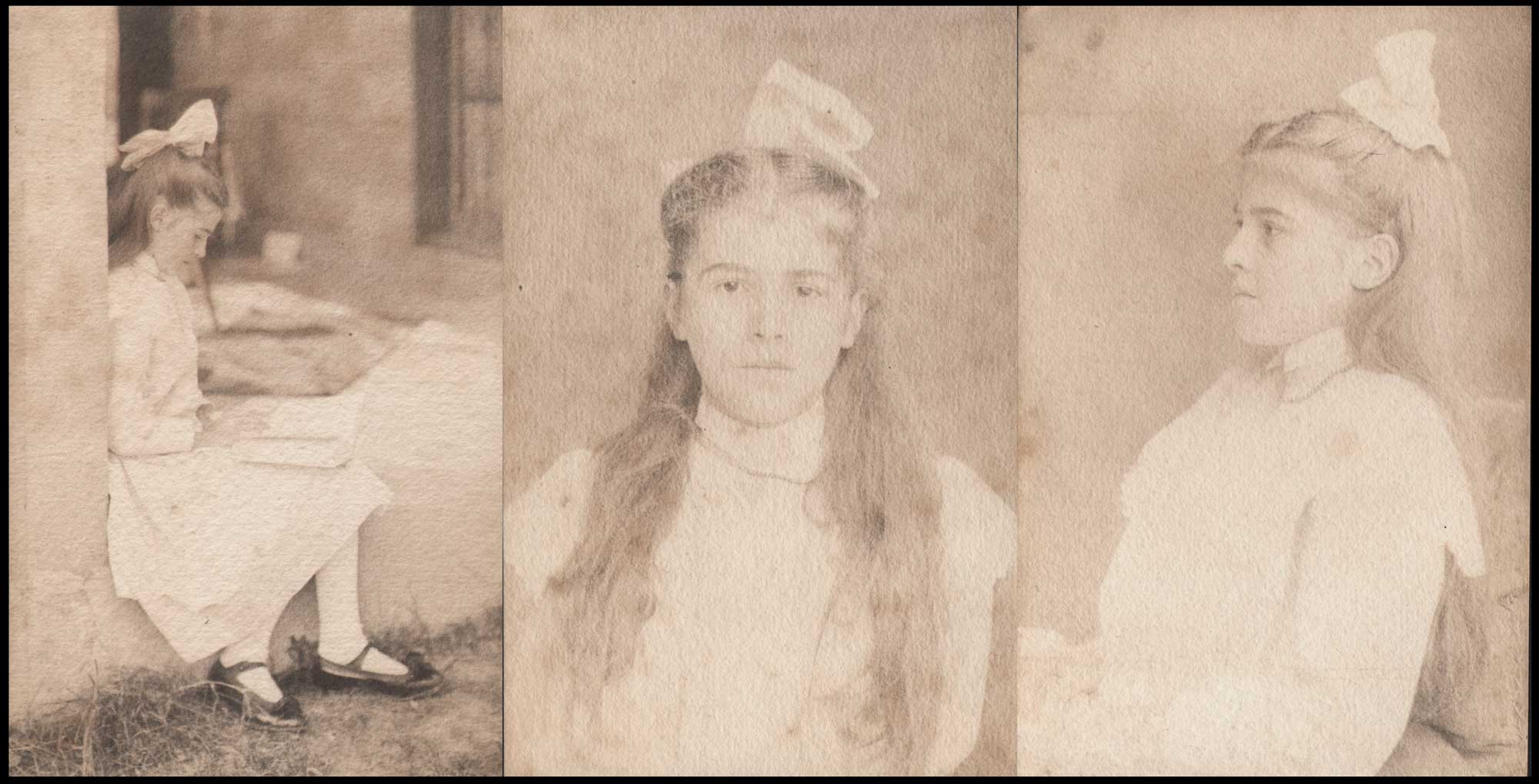
Another series of Dorothy Tucker posing outside the family home, then at 90 Third Street in the New Dorp section of Staten Island. Left: “Dorothy Reading on the Veranda”, Middle: “Portrait of Dorothy”, Right: “Profile of Dorothy”, all: ca. 1908-09, rough, unmounted platinum paper prints, C.R. Tucker, American 1868-1956. L: 17.6 x 11.4 cm; M: 16.8 x 11.5 cm; R: 18.3 x 12.0 cm. These high-key prints may have been deliberate in the printing process or test prints, as one other known example from this sitting not held by this archive is much darker. From: PhotoSeed Archive

“Dorothy, with Eyes Shut”, ca. 1909-10, unmounted gelatin silver print, C.R. Tucker, American 1868-1956. 16.7 x 12.0 | 17.2 x 12.9 cm. A misfortunate, yet aesthetically fortunate result. With a “blizzard” of spots surrounding her, Dorothy Tucker (1899-1986) seems to retain an inner peace as an artificial maelstrom is kept at bay outside the world of her closed eyes. These heightened effects on this finished print were most likely caused by, but not limited to: improper fixing, toning and prolonged exposure to adverse elements in storage. Combined, they introduce added mystery to an already dramatically-lit, three-quarters profile portrait of a young woman embarking on her teenage years. From: PhotoSeed Archive
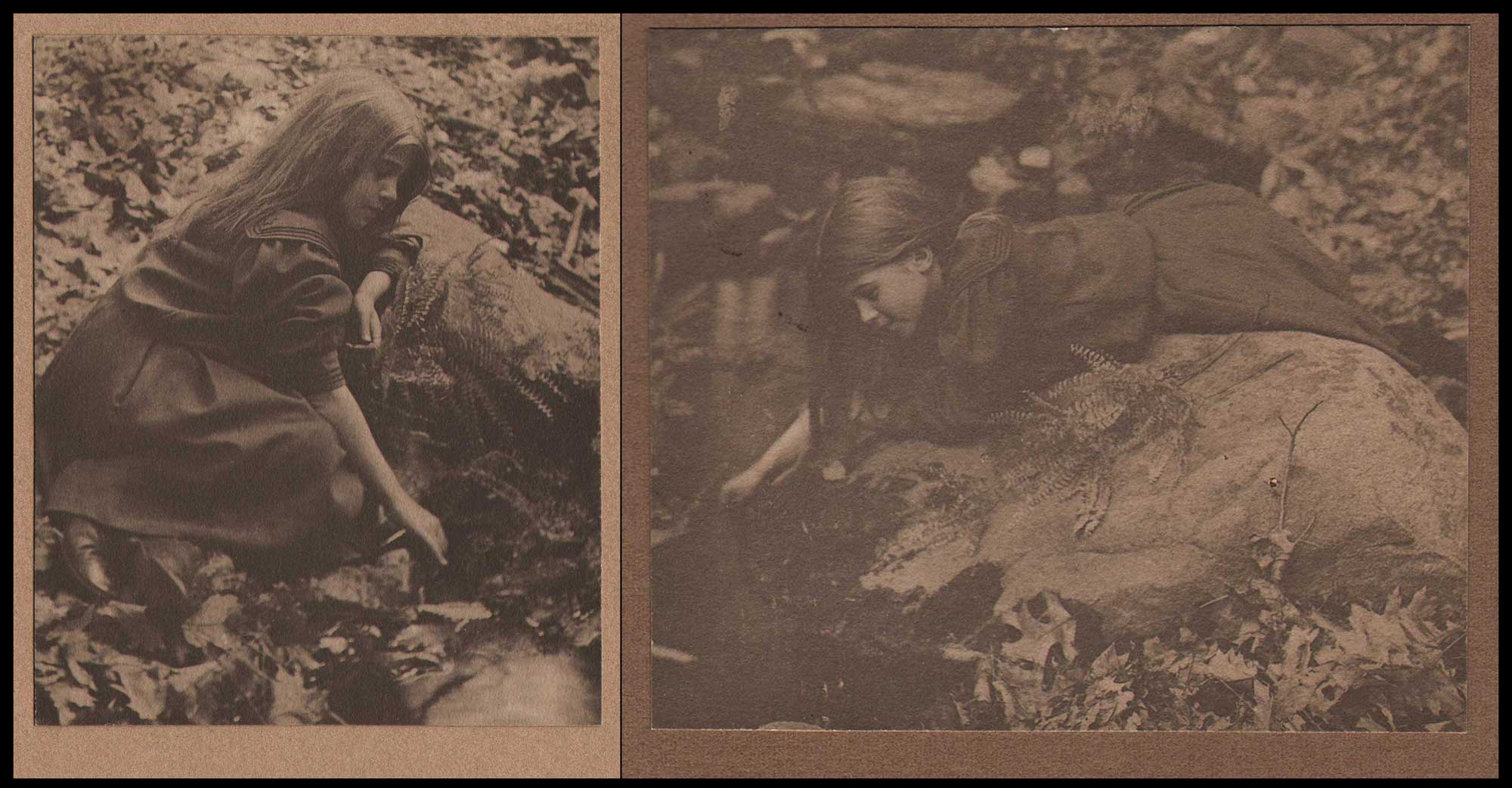
Exploring Nature. Left: “Dorothy Tucker Gathering Ferns”, Right: “Dorothy Leaning over Boulder while Touching Stream”, both: ca. 1910-12, mounted platinum prints, C.R. Tucker, American 1868-1956. Like her father-photographer, who was a member of the Staten Island Institute of Arts and Sciences as well as the Natural Science Association of Staten Island since 1903, Dorothy, through the evidence of multiple photographs held by this archive, seemed interested in nature. At left, she clutches a spray of freshly-picked ferns while investigating the edge of a stream in the woods. At right, she leans over a boulder while placing her fingers in a stream in the woods, the clutch of ferns she had gathered earlier placed on the boulder in foreground. From: PhotoSeed Archive

Dorothy as Photographer: Given the attention she received on the receiving end of her father’s amateur photography, it’s not surprising Dorothy also took up the camera. The center photograph of C.R. Tucker, taken in VT, was mailed as a photographic postcard to Dorothy’s grandmother Myra Frances Talbot (Tucker) 1846-1927, ca. 1911. It’s addressed to her as Mrs. G.L. Tucker, 76 Morton St. Stoughton, MA with writing by Dorothy: “Dear Grandma:- Here is a picture of father that I took when he didn’t know it. He is picking raspberries and just putting one in his mouth. He says it was the only one he ate all the time he was picking, but I saw him eat three. Lovingly, Dorothy”, gelatin silver rppc, 8.8 x 12.4 cm. Two other additional views of Dorothy’s parents were also believed taken by her. These were done ca. 1910-15 outside the family home at 90 Third St. in New Dorp, Staten Island, N.Y. Left: “Mary Carruthers Tucker, 1877-1940 Next to Pergola”, 7.9 x 5.4 | 12.7 x 8.0 cm, Right: “Charles Rollins Tucker mows Grass next to Pergola”, 7.9 x 5.4 | 12.4 x 7.0 cm. From: PhotoSeed Archive
Not all of the Dorothy photographs became degraded by the elements. But for many, moisture damage, mildew, and other impacts of improper storage by their former caretaker: Dorothy’s kid brother Stephen “Jerry” Tucker- who had been renting that now long demolished home- piled on for about ten years or so after he died in late 2001. But for those fascinated by an artistic, comprehensive record of a young girl growing up at the turn of the 20th Century, a generous thank you is in order for his care of the photos before Pam’s rescue efforts.

“Luncheon”, ca. 1910-12, unmounted gelatin silver print, C.R. Tucker, American 1868-1956. 26.6 x 21.5 cm. Dorothy, perhaps a very young teenager at this point, sits on the rear concrete steps to the Tucker family home at 90 Third Street in New Dorp, Staten Island and uses a spoon to eat from a bowl set on her lap. The Tucker family were believed to be the second owners of the home, now demolished, and originally built for “Mr. W.J. Steel” as described as part of the article “Some Modern Concrete Country Houses” in the August, 1906 issue of American Homes and Gardens. From: PhotoSeed Archive
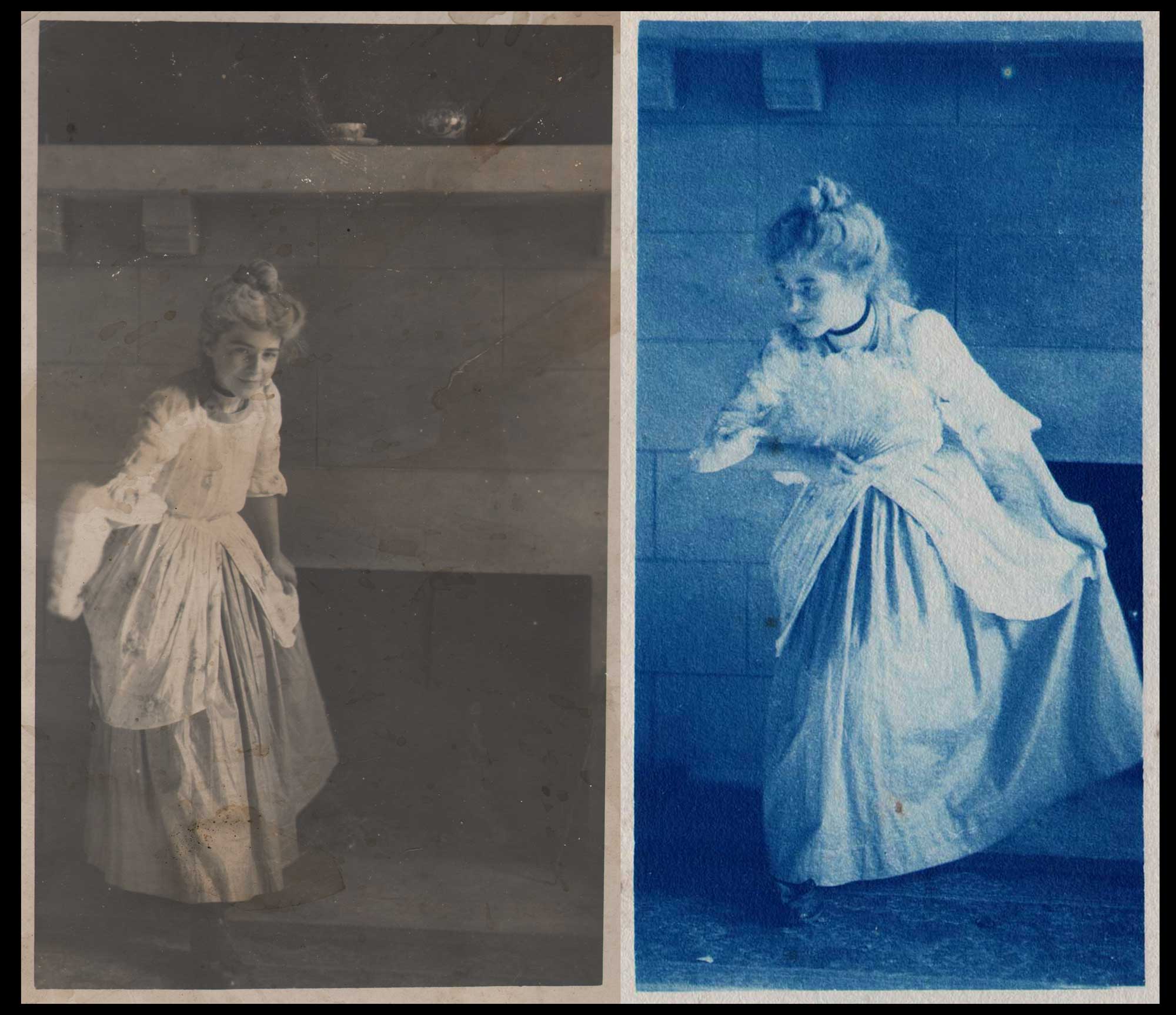
A playful and performative side of Dorothy emerges in young adulthood. Two photographs believed not taken by C.R. Tucker but by an acquaintance: with handwritten initials “F.L.C.” and date May 18 1912 written on cyanotype folder, show Dorothy inside the Tucker family dining room at 90 Third Street in New Dorp. Not quite 13 years old, she strikes several poses using a fan-perhaps as part of a school play performance she would later take part in. Left & Right: “Dorothy Tucker with Fan”, 1912, unmounted gelatin silver and mounted cyanotype prints: 18.1 x 10.7 | 27.7 x 15.5 cm; 16.5 x 8.6 | 22.0 x 11.3 | 22.6 x 12.3 cm. From: PhotoSeed Archive

Dorothy plays the grown-up: “Dorothy Tucker holds brother John Robert Tucker”, 1914, gelatin silver rppc stock, C.R. Tucker, American 1868-1956. 12.4 x 7.8 cm. Notation indicating John Robert on postcard verso states he was one month old when this photograph was taken. Born March 3, John Robert Tucker: 1914-1991, became an electrical engineer, and was listed as working for the U.S. Testing Company of New York City on his 1941 marriage certificate. From: PhotoSeed Archive

“Dorothy plays Mandolin on Veranda”, ca. 1914-15, unmounted rough platinum or bromide print, C.R. Tucker, American 1868-1956. 20.9 x 15.7 cm. Now with short hair, Dorothy plays a mandolin on a swing set up in the veranda of the Tucker family home at 90 Third street in New Dorp, Staten Island. From: PhotoSeed Archive
The icing on the cake? “Jerry” was safeguarding a lot more than these Dorothy photographs. As it turned out, he was preserving the early photographic legacy of his father: Charles Rollins Tucker, and a trove of his amateur images dating back to the late 1880’s. One of these, from 1889, mounted on a cabinet card, was of the famed elephant Jumbo, now stuffed, and standing on a platform before being installed in a new museum of natural history erected by P.T. Barnum on the campus of the present day Tufts University outside Boston.

Upper left: “Dorothy, 16 Years Old”; U.R.: “Dorothy with Pony & Trap”; Bottom: “Dorothy with Pony”, all: ca. 1916-17, unmounted gelatin silver prints, C.R. Tucker, American 1868-1956. U.L.: 18.5 x 13.2 cm; U.R.: 6.9 x 8.6 cm; Bottom: 5.5 x 7.7 cm. Dorothy wears a headband, fashionable for young women during this period. Most likely on the 125 acre family farm located in Randolph, VT, Dorothy guides her pony and trap while going for a ride. The two children with her may be her younger siblings, brothers John Robert, b. 1914 and Stephen Jeremiah, b. 1915. Below, Dorothy kneels and nuzzles with her pony, also most likely taken at the Randolph farm. From: PhotoSeed Archive
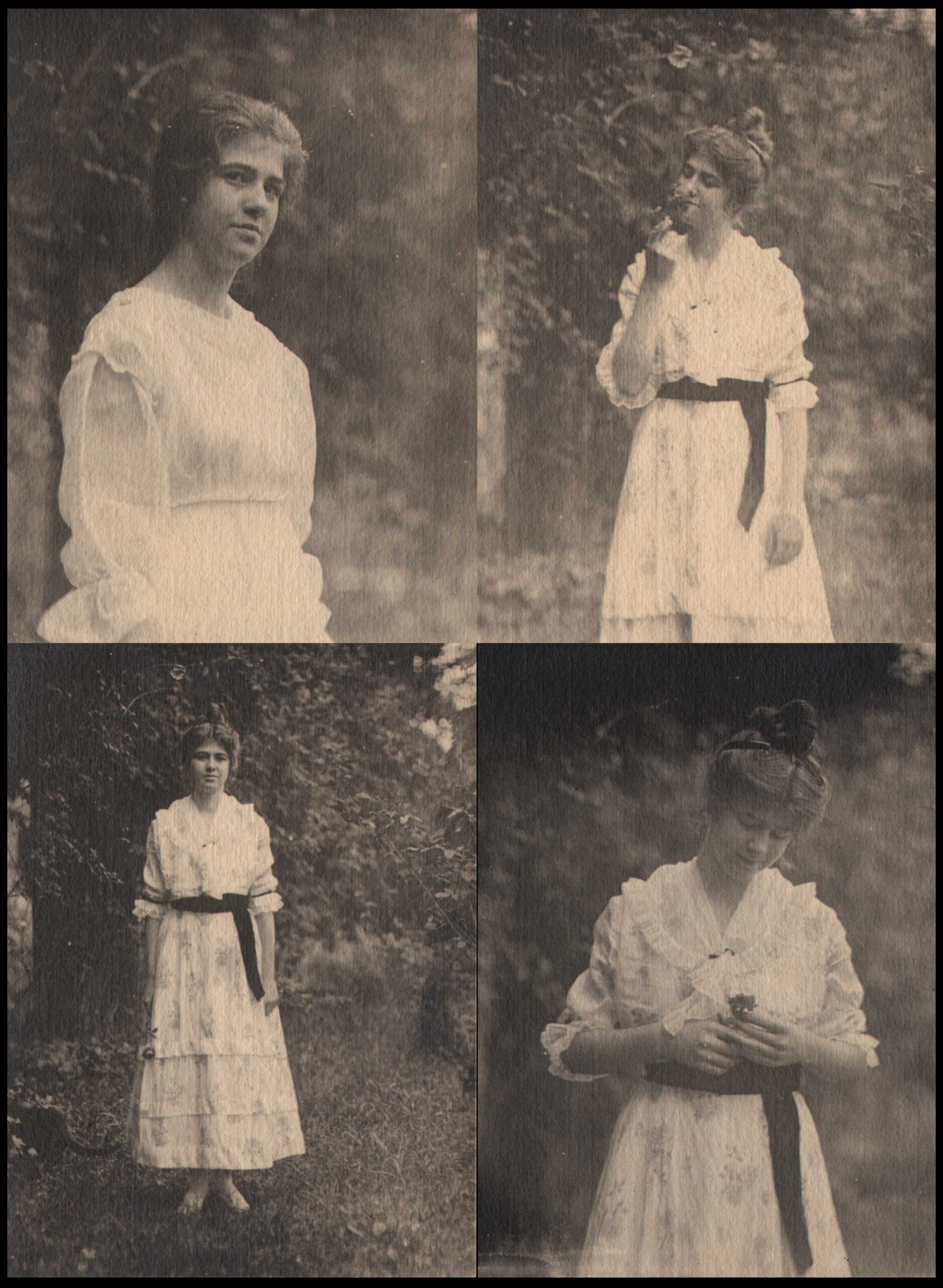
Probably High School Graduation Portraits: All: “Dorothy Tucker Poses near Pergola at New Dorp Home”, ca. 1917, unmounted rough, gelatin silver prints, C.R. Tucker, American 1868-1956. Most being 9.5 x 7.1 cm or slightly larger. One of the concrete block columns for the pergola at the New Dorp home can be seen at background left in several of these portraits, perhaps some of the last taken of Dorothy before she headed off for Tufts College in pursuit of her AB degree in the Fall of 1917. From: PhotoSeed Archive
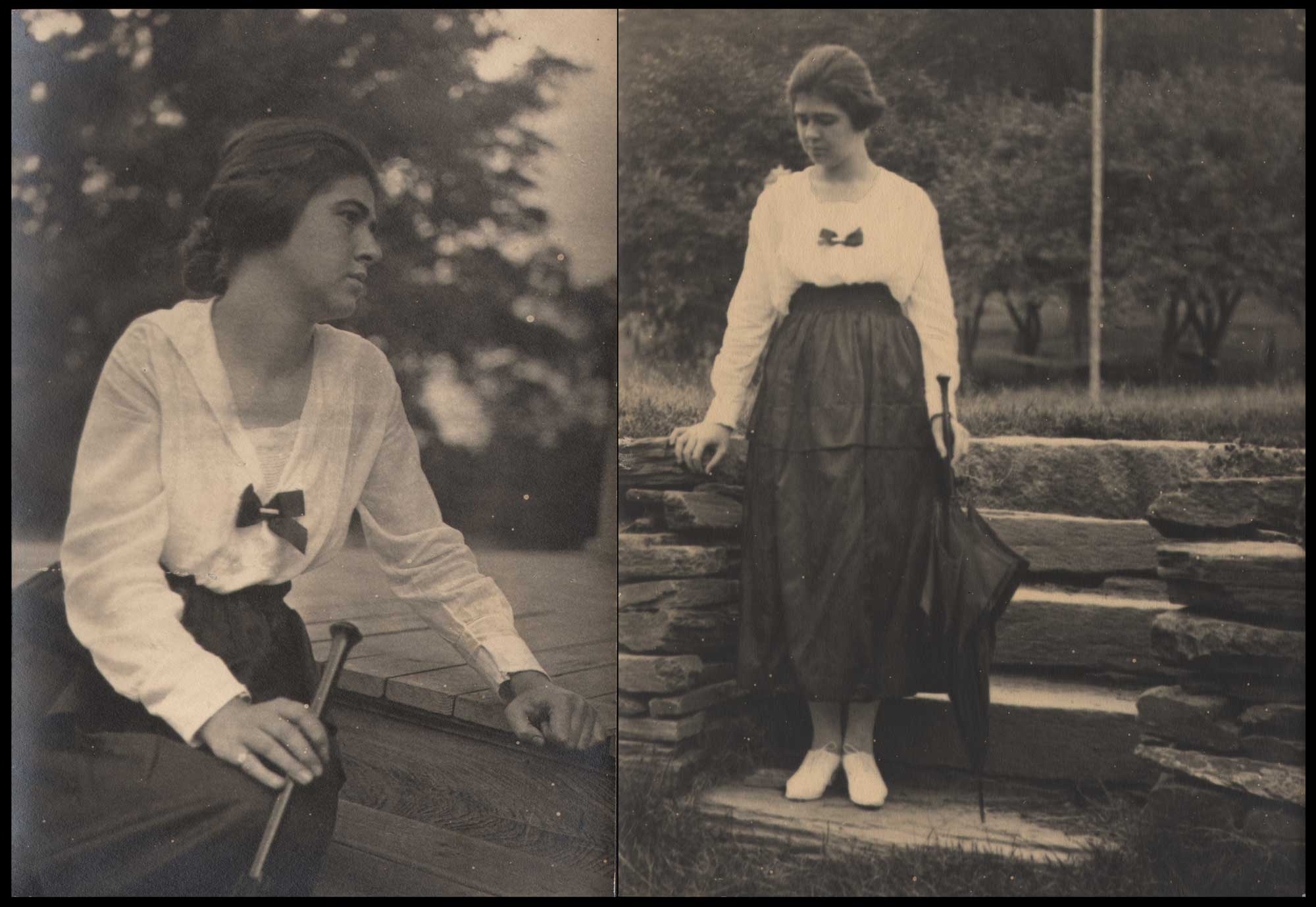
Most likely a college student. Left: “Dorothy Seated with Umbrella”, Right: “Dorothy Standing with Umbrella”, ca. 1917-18, unmounted gelatin silver prints, C.R. Tucker, American 1868-1956. L: 18.9 x 12.8 cm; R: 24.8 x 19.2 cm. In late 1917, Dorothy had matriculated at Jackson College for Women at Tufts College in pursuit of her AB degree, and later the same year her parents sold the New Dorp house, with the 1920 US Census showing her living at the Randolph, VT farm along with her mother and two brothers. (Her father continued to teach in the New York Public school system and its assumed he commuted to VT on weekends, etc.) From: PhotoSeed Archive
But wait, there’s more: the trove also included mounted exhibition and “postal photographic club” images done in platinum, bromide, gelatin silver, carbon, cyanotype, and other processes by C.R. Tucker and his many fellow amateurs and professionals. Besides New England based photographers and the New York residence of Tucker himself, work by gifted amateurs from as far away as Illinois and North Carolina– some of the only known extant examples of these mostly unknown amateurs were saved.

College graduate: “Dorothy Tucker standing in Graduation Gown on Randolph, VT Farm Porch”, ca. 1920, unmounted gelatin silver prints, C.R. Tucker, American 1868-1956. L: 4.7 x 4.0 cm; M: 5.6 x 4.5 cm; R: 4.7 x 3.4 cm. Dorothy received her Bachelor of Arts degree as a member of the Jackson College for Women at Tufts College during commencement on June 21, 1920. Here she poses in her graduation gown on the family farmhouse porch in Randolph, VT. It would have been a prideful moment for Dorothy’s father, as he had received his bachelors and masters degrees from Tufts in 1891 and 1894. From: PhotoSeed Archive
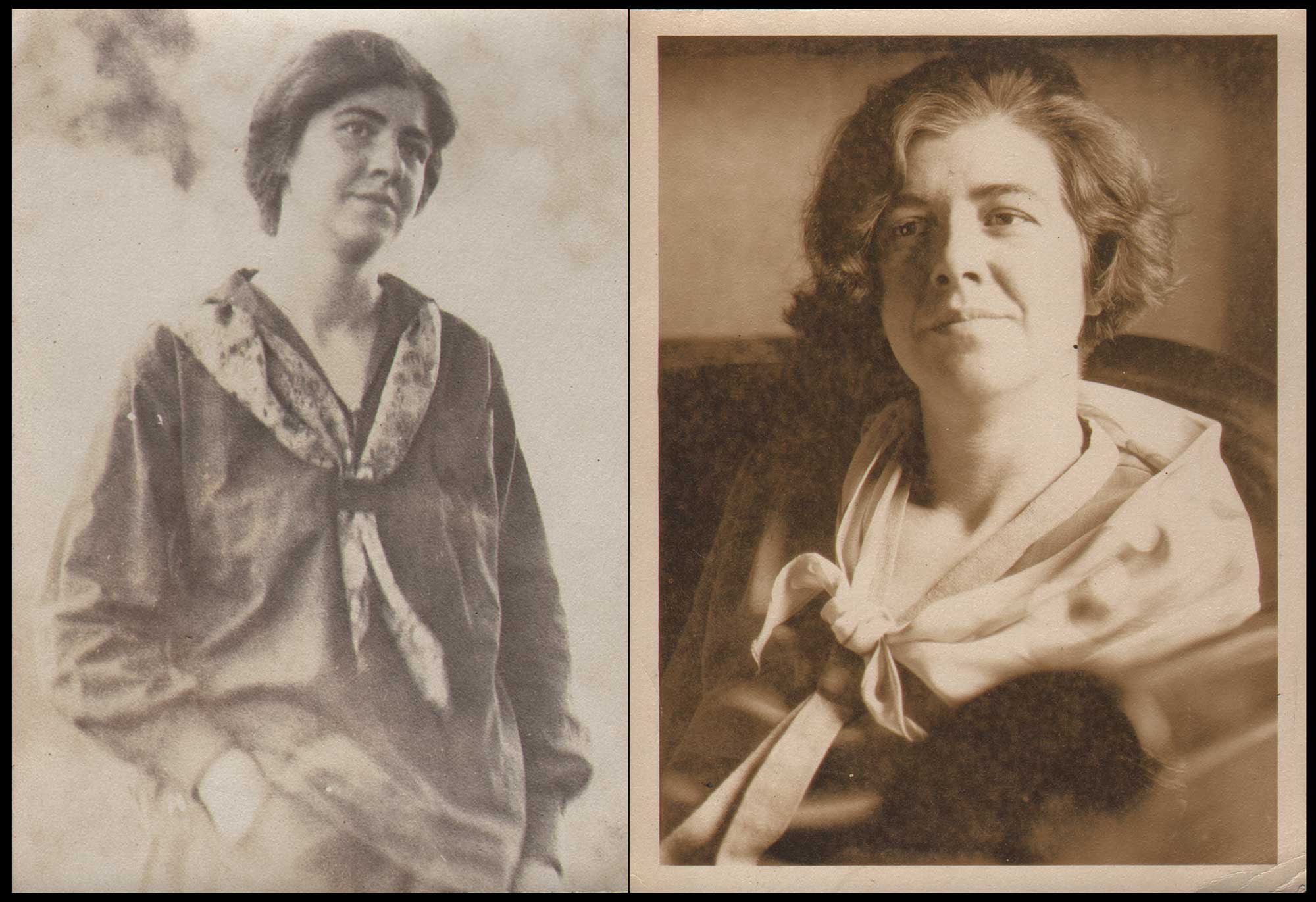
1920’s: Although undated, these two portraits of Dorothy Tucker were most likely taken when she was in her early 20’s, like the example at left, and perhaps in the later 1920’s at right. Left: the three quarters length photo (bromide print- 8.2 x 5.7 cm) of her was hand-printed by C.R. Tucker, while the photo at right (bromide: 10.0 x 7.4 | 10.7 x 8.2 cm) is commercially printed, but also believed to be taken by him. At some point after Dorothy graduated from Tufts in 1920, she would move to Cambridge, MA to be closer to her job working within the Harvard University Libraries system. Now, with the reality of being grown up and on her own, the days of Dorothy willingly being her father’s photographic subject at a moments notice were curtailed but certainly not stopped, as it’s known C.R. Tucker loved taking pictures well into the 1940’s. From: PhotoSeed Archive
Enjoy this fascinating progressive “snapshot” of Dorothy’s early life. With most mounts lacking written dates, I’ve tried to give reasonable date estimates based on her appearance in the individual series of photos.
Many years ago, as a working professional but wearing my own “dad-photog” hat, I took a once-a-year birthday portrait of my own daughter seated on the same dining room chair for the first 18 years of her life. Capturing a deliberate progression in photographs of someone’s early life can be inspiring. In that spirit and with the evidence here of Dorothy’s “rescued” life, will you not also take up the challenge?
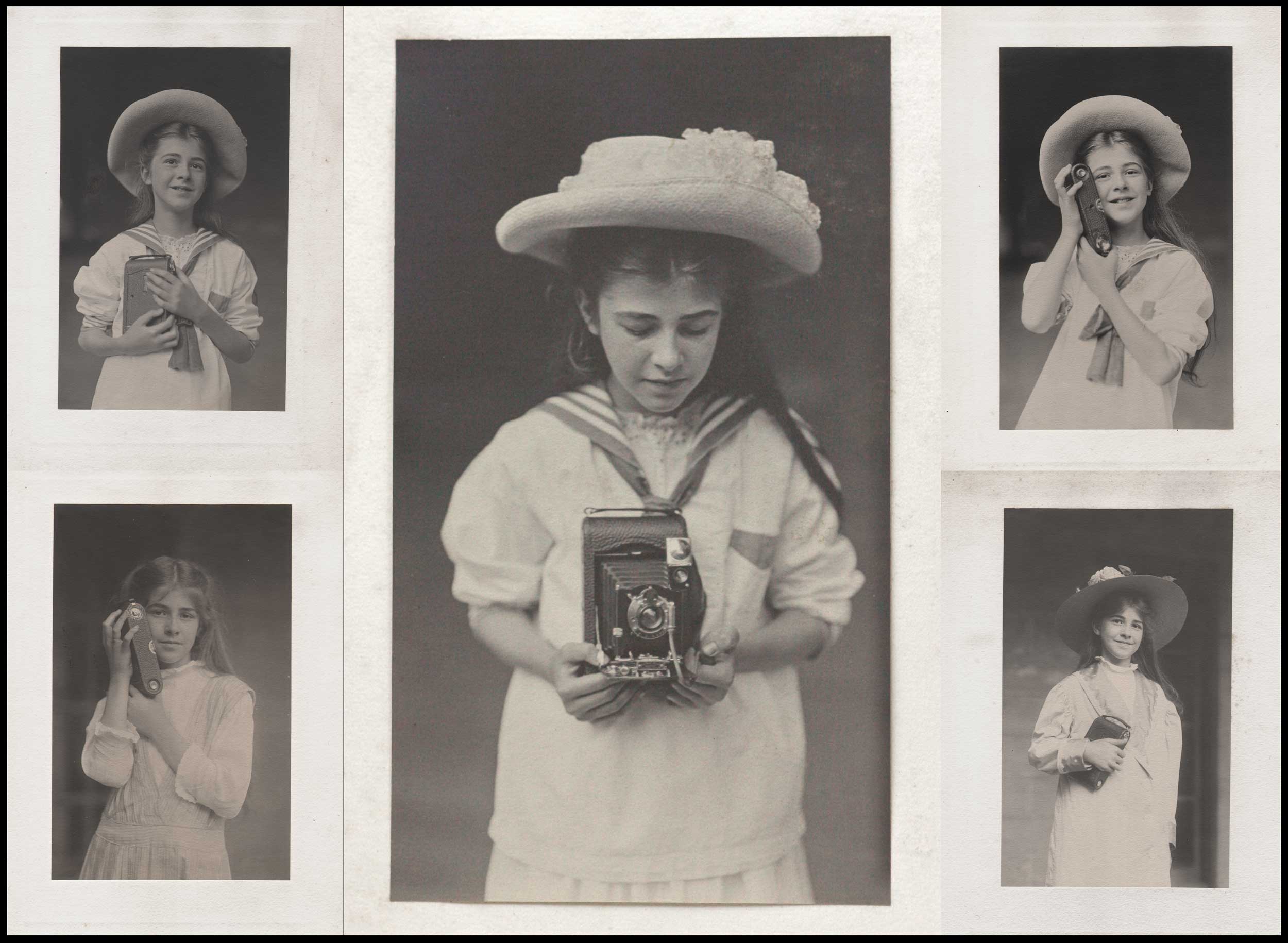
Series: “Dorothy Tucker with Kodak Cameras”, ca. 1908-10, mounted platinum prints, C.R. Tucker, American 1868-1956. UL: 22.4 x 14.1 | 33.9 x 24.9 cm; LL: 22.0 x 14.0 | 33.9 x 24.9 cm; Center: 22.9 x 13.2 | 33.5 x 23.6 cm; UR: 22.8 x 14.0 | 33.6 x 24.1 cm; LR: 20.8 x 12.6 | 34.1 x 23.8 cm. Precedent had been set employing Dorothy as a model for photographic equipment. In 1907, Charles Rollins Tucker’s photograph of his daughter holding a cat was published as an advertisement in Camera Work and other photographic journals. This was for Bausch and Lomb-Zeiss Tessar lenses. This series of portraits were taken later however. With the verso of the mounts all including the designation “621-B” in blue editor’s pencil, for entrant # and category, they are believed to have been entries for one of Kodak’s annual advertising contests, open to amateurs nationwide. Wearing different outfits, including two different hats as well as a sailor-type dress with scarf and another outer jacket, Dorothy nuzzles up to and displays a Kodak camera, probably the 3A model, in the closed position in the four corner photographs. With the bellows extended and camera open at center, Dorothy holds steady, her hand grasping a rubber bulb shutter to make the exposure while looking down and framing the shot through the viewfinder. The background shows she stood outside the family home at 90 Third street in the New Dorp section of Staten Island but it’s unknown if any of these resulting photographs became prizewinners. All: PhotoSeed Archive
Timeline: Dorothy Frances Tucker: 1899-1986
1899: Born in Stoughton, MA on August 27th.
1900: U.S. Census shows her living with her mother (Mary Carruthers Tucker) and father C.R. Tucker at 73 Clifton Place in Brooklyn, N.Y. The family would soon move to 4 Wall Street in New Brighton on Staten Island.
1907: Portrait of Dorothy holding a cat appears as part of an advertisement for Bausch and Lomb-Zeiss Tessar lenses “Home Portraits” in Camera Work XVII for January.
1910: U.S. Census shows Dorothy living with her mother and father at 90 Third St. in the borough of Richmond, N.Y. (Staten Island)
1914: Dorothy’s first brother, John Robert Tucker, (1914-1991) is born on March 3 in Staten Island.
1915: Dorothy’s second brother, Stephen Jeremiah “Jerry” Tucker, (1915-2001) is born on April 24th in Vermont.
1917: Dorothy Frances Tucker listed in Tufts College Jumbo Yearbook as matriculated. Pursuing her AB degree. Lists being from New Dorp (Staten Island) and graduate of Curtis High School.
1920: Dorothy receives her Bachelor of Arts degree as a member of the Jackson College for Women at Tufts College on June 21st as part of the 64th Annual Commencement. (Catalogue of Tufts College 1919-1920)
– U.S. Census lists Dorothy living in Orange County, VT with her mother and two brothers. Her mother listed as head of family. Her father was still working in New York City and may be reason he is not listed on Census. The family would eventually purchase a 125 acre farm in Randolph, VT, which they were most likely already living at in 1920.
1920-30: At some point during this decade, Dorothy was working professionally within the Harvard University Libraries system, living in Cambridge, MA.
1924: Still living in Randolph, VT, Dorothy is listed as attending the Summer session in the English school at Middlebury College. Middlebury, VT.
1925: On the New York State Census, Dorothy’s occupation is listed as teacher. She lives at 13 Greene Ave. in Brooklyn along with her father, also a teacher, and two younger brothers.
1930: At the time living in Cambridge, MA, Dorothy marries Charles Roland Tinkham in Randolph, VT on March 16. (Charles Roland Tinkham: 1886-1963) It was the second marriage for Tinkham, and Dorothy now had a stepson and stepdaughter: Roland Charles Tinkham: 1914-1994 & Edith Katharine Tinkham Costa: 1920-2003.
1931: Approximately. Dorothy retires from Harvard University library work to be a wife and mother on a Middleboro, Mass. farm.
1932: Daughter Priscilla Barbara Tinkham born. Priscilla Barbara (Tinkham) Marshall: 1932-2010
1934: Son Henry Tinkham born. Henry Tinkham: 1934-2019
1940: Her mother Mary (Carruthers) Tucker dies in Boston. Mary Carruthers Tucker: 1877-1940
– U.S. Census: Dorothy’s family living at 142 Highland St., Middleborough, MA.
1956: Her father Charles Rollins Tucker passes away near Middleboro, Mass., on May 28.
1963: Her husband Charles Roland Tinkham (1886-1963) dies in May. Source: Middleboro Gazette Index: Tinkham, Charles Roland Obituary, 05/02/1963:5
1986: Dorothy passes away in Middleboro, MA on July 19th. Obituary in Middeboro Gazette:
Mrs. Charles R. Tinkham
Stoughton native
MIDDLEBORO – Dorothy F. (Tucker) Tinkham, 86, of 94 Everett St. died July 19 at St. Luke’s Hospital. She was the wife of the late Charles R. Tinkham.
A native of Stoughton, she was the daughter of Charles R. and Mary (Carruthers) Tucker. Mrs. Tinkham was graduated from Tufts University with a degree in library science and was a member of Tufts University Alumni Association.
Prior to her retirement, she had been employed as a bookkeeper at H. Tinkham and Sons Garage and Maxim Motors.
She is survived by two sons, Henry Tinkham of Middleboro, and Roland C. Tinkham of Sanbornville, N.H.; two daughters, Priscilla B. Marshall
of Raynham and Edith K. Costa of Lakeville; two brothers, Stephen Tucker of Pennsylvania and Robert Tucker of New Jersey; 10 grand-children, five great-grandchildren and one great-great-grandchild.
Graveside services were held Monday at Hope Rest Cemetery.
Donations may be made in her memory to the American Heart Association, 1105 West Chestnut St., Brockton, MA 02401.
✻ ✻ ✻ ✻ ✻
Afterword: Remembrance
The following loving remembrance of Dorothy from her later years is courtesy of Shannon Lacombe, her great granddaughter, as recounted by Judith Gibbs, Dorothy’s step-granddaughter:
“Another thing about your great-grandmother: she was a totally different woman when it came to her own children & grandchildren. You could see the Sun rose & set on them. Remember, I wasn’t her blood, but she was very kind & made me happy to be at the farm. She was very smart, my mother told me about her being highly educated & the head & first female librarian at Tufts in Boston? (or something equivalent to that.)
She was artistic, she made the most beautiful greeting cards for me all by hand, used dried flowers, even hay, anything from the farm, from nature, they were exquisite! I wish I had saved even one of them.
Sewing! My doll was the best dressed in the whole town. She could sew, wow, could she sew, I had the only doll with a mink coat! Actually it was rabbit: they were poor, so grandpa & the male cousins had to help hunt for meat, and she took the fur and made a coat and hat for my doll. She had a large flower garden in front of the house. She also had a way with flowers, and the front yard was like a gardener’s magazine!
I know most people at that time did canning, but grandma’s jams, whole fruits, anything & everything you could can she did & it always tasted so much better than anyone else’s. Her baked goods and pastry were to die for. I know most grandchildren say that about their grandmothers, but ours had to use a wood stove to cook on, with no running water in the house. Try cleaning up your kitchen with no running water, but she did and she did it so much better than those with running water you could eat off her floors. She was amazing.” (lightly edited)
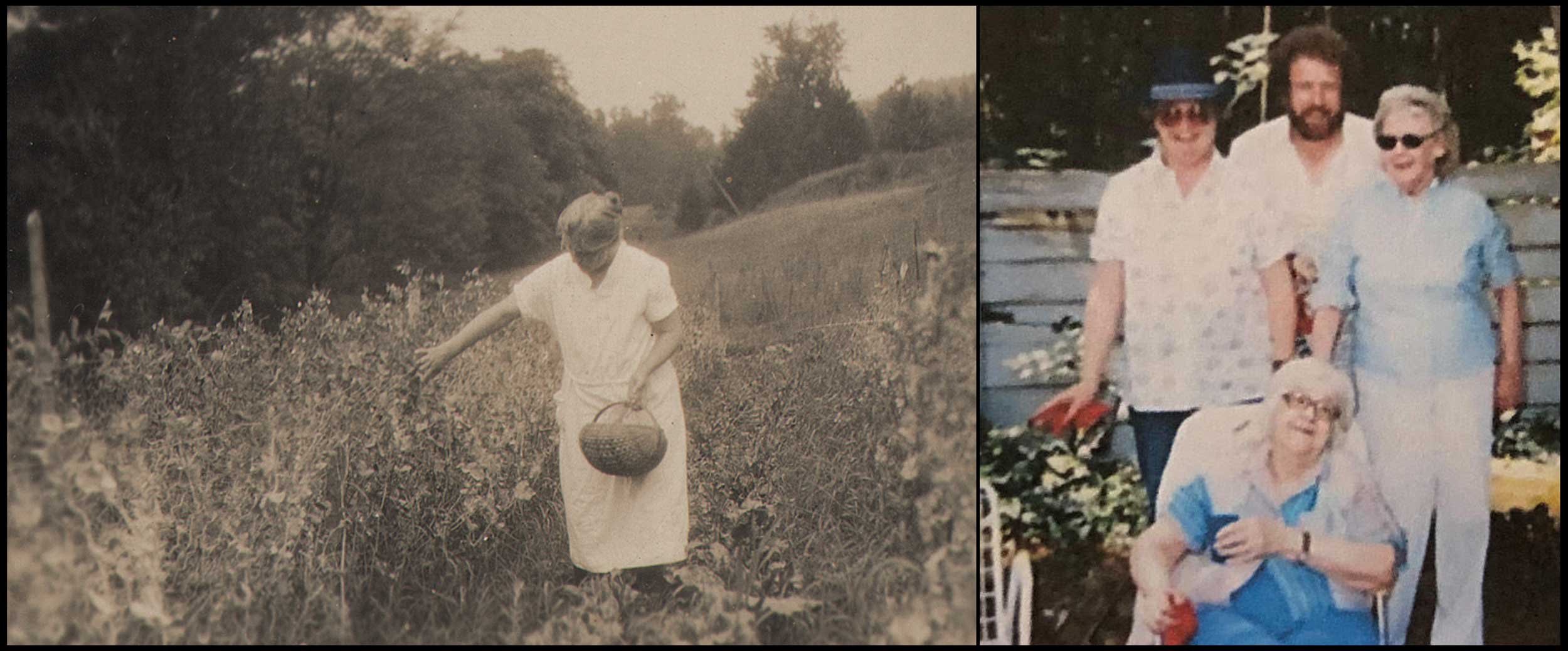
Left: “Mother in her Garden”, probably ca. 1950’s by unknown Tucker family photographer, unmounted gelatin silver print, 5.4 x 8.0 | 17.7 x 12.8 cm. Dorothy Tucker Tinkham holds a basket while working in her Middleboro, MA home garden. From: PhotoSeed Archive. Right: In a photograph taken near the end of her life, Dorothy is shown seated at front along with her two children Priscilla and son Henry, and stepdaughter Edith at right. Photo courtesy Stanley Miller via Shannon Lacombe
Shannon Lacombe also noted Dorothy’s legacy continues to nurture an artistic bent running within her own family:
“It was definitely amazing to hear that she (Dorothy) was so artistic, which she passed on to her daughter Priscilla. And though my father did not know anything about them, he is also rather artistic…which I have inherited as well.”
